An inner-city development that prevents more than 75% of its stormwater runoff from draining to the public drainage system: no impacts to the local river in almost all storms, and a much reduced contribution to flooding problems in the few storms each year that do cause it to overflow. The system relies on two small, productive, well-watered gardens that keep our household in herbs and vegetables (and, now that the grapevine and gingko tree have grown, provides cooling shade to the back deck), without the need for mains water, and a small rainwater tank that takes up less than 1% of the property area. The tank provides about a third of the water used by our house, by supplying our toilets and washing machine. This diary describes the system’s design, construction and on-going performance.
1. The plan… 2. The build… 3. First plantings, first floods retained…
4. First summer, first harvest, more flood mitigation, the gingko finds its wet feet…
5. A year in: increasing our water demand, lifting the trees higher, plenty of water through a dry spring and summer…
6. A 2-year performance stocktake, early days for the grape and passionfruit vines…
7. Years 3, 4: coping with heavy rain, cleaning out the charged downpipes, stormwater fed quail eggs, decline of the passionfruit vine, possum (1) v. grapevine (0)…
8. Year 5: the grapevine fights back, pump pitfalls, a bigger thirstier grapevine, passing the low-maintenance test ….
9. Year 6: Fixing leaks; death of a passionfruit, boom of a grape; the ABC visits; a bumper grape crop brings shade and wildlife.
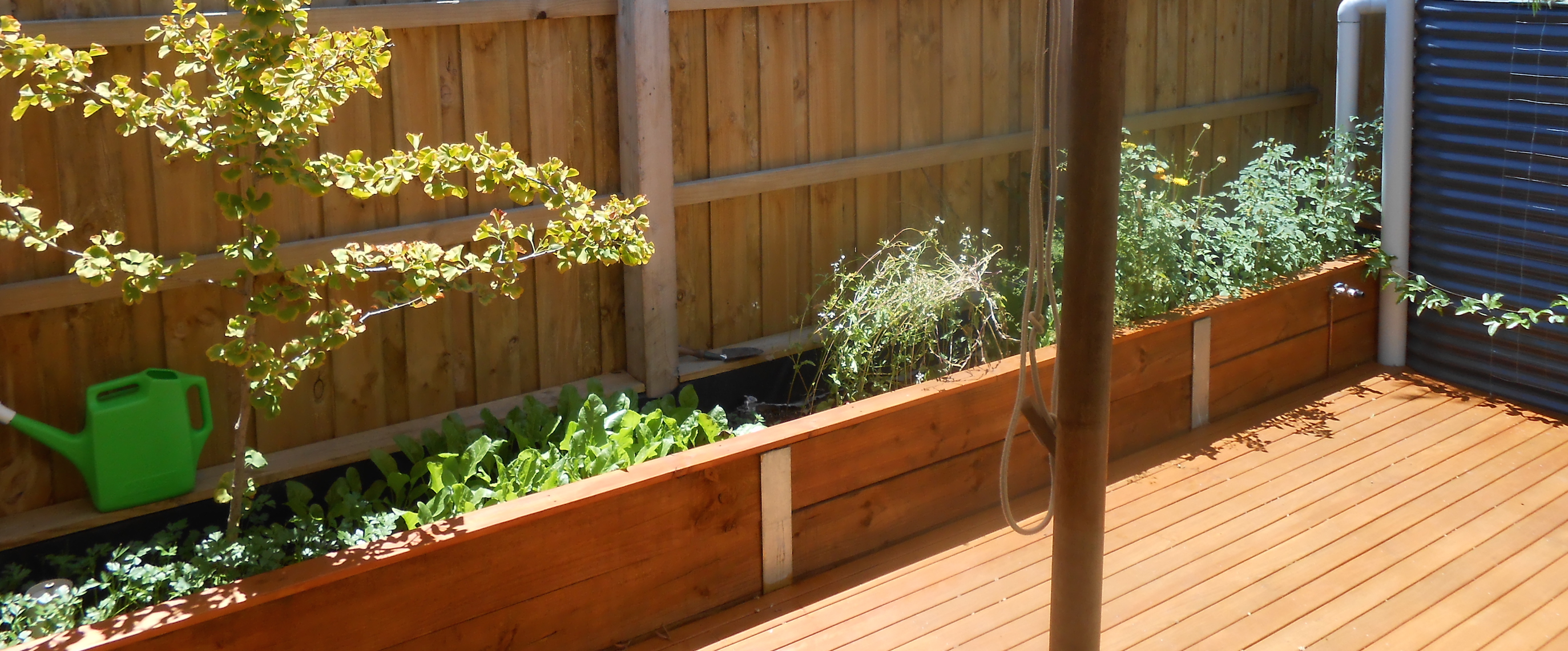
Part 1. The plan
We have renovated our small house in Richmond, an inner suburb of Melbourne. The house sits on a 160-m2 block, and now we have pushed out to the boundary in a few places, our roof area is 121 m2. Only a square metre or so of brickwork at the front gate drains to the street. With our new stormwater system, no runoff should leave the property from any surfaces other than this square metre of brickwork, except in the largest of storms. (If your initial reaction to this is ‘but won’t you be starving the local river of valuable flows?’, please have a browse through the links at urbanstreams.net, maybe starting with this post: the short answer to this question is ‘no’.)
We have installed a 2,750-litre, slimline tank along the back wall of our courtyard, and all of the downpipes (draining about 117 m2 of roof), except 1 (draining ~4 m2), drain to the tank via a charged system. Each of the downpipes has a rain-head with a fly-wire screen to prevent debris flowing down the pipe, and to keep out mosquitoes. This was particularly challenging for two downpipes on walls along the boundary, where we only had 150 mm between the wall and the boundary. I managed to source two frogmouth filters, narrow enclosed filters that are no longer manufactured, from a supplier in Perth. The small amount of water that splashes out of these filters is directed through a second pipe into the small garden outside our kitchen.
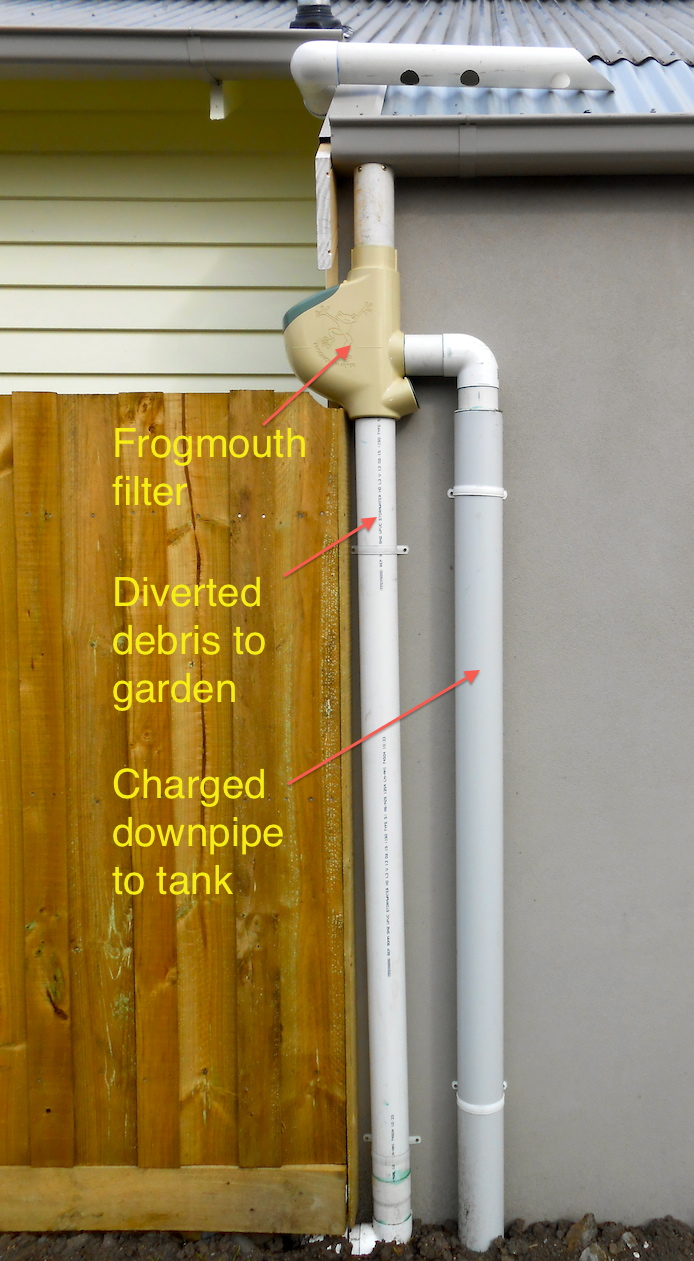
The 100-mm sewer-grade downpipes connect under the house to the tank. The pipe system under the house has a slight slope to a purge point at the front corner of the house: in case the system ever needs to be emptied, it can be drained slowly onto the small front garden.
The tank is plumbed into the two toilets in the house and the washing machine, and we will use it to water our 6 m2 of garden (normal garden beds, separate from the rain gardens described below), with a Vada V80-H pump with a rain-to-main attachment, to allow automatic switching to mains water if the tank runs dry. (The specs for the pump suggest performance similar to the most efficient pumps monitored in the Little Stringybark Creek study, and so providing water at 1.2 kWh/kL: we have one gravity-fed tap in the courtyard that I use [while the tank is more than ~one-quarter full] for most of our garden-watering: ~40 L/d in summer).
According to the environmental benefit calculator, with four of us in the house, the tank should provide 45,000 litres for those purposes in an average year, still substantially less than the 65,000 litres of runoff that the roof will generate. (Although the calculator predicts that the tank will only overflow 9 days per year).
So, the tank overflows to two connected rain-gardens (plans here), which I hope will lose sufficient water to make overflows from them a rare event. However, because they are both close to constructions they need to be completely sealed (with heavy-duty pond-liner), and we need to rely on loss to the air through evapotranspiration. As their total area, is only 5.1 m2, transpiration losses from within the garden area will be small: in fact the calculator predicts that the rain-gardens will make no difference to the runoff frequency. (Actually the runoff frequency will initially [while the plants are growing] be a little higher than 9 days per year, because the front rain-garden also directly receives runoff from the 4 m2 of roof that isn’t connected to the charged system).
But I have a cunning plan. The two rain-gardens are really just big planter pots, and I aim to grow vines and trees in them that will spread their leaves well beyond the area of the garden to increase the effective area for evapotranspiration. If I were able to increase the effective area of the rain-gardens to 15 m2, then the calculator predicts runoff from the property on only 3 days per year. That’s the aim – well watered vines to provide shading and cooling in summer, to make our house a more comfortable place to be, and that is having almost no runoff impact on the Yarra River down the road.
The construction of the system is a learning process for me, which I will document here, in the hope that my lessons might be of use to others
Part 2. The build
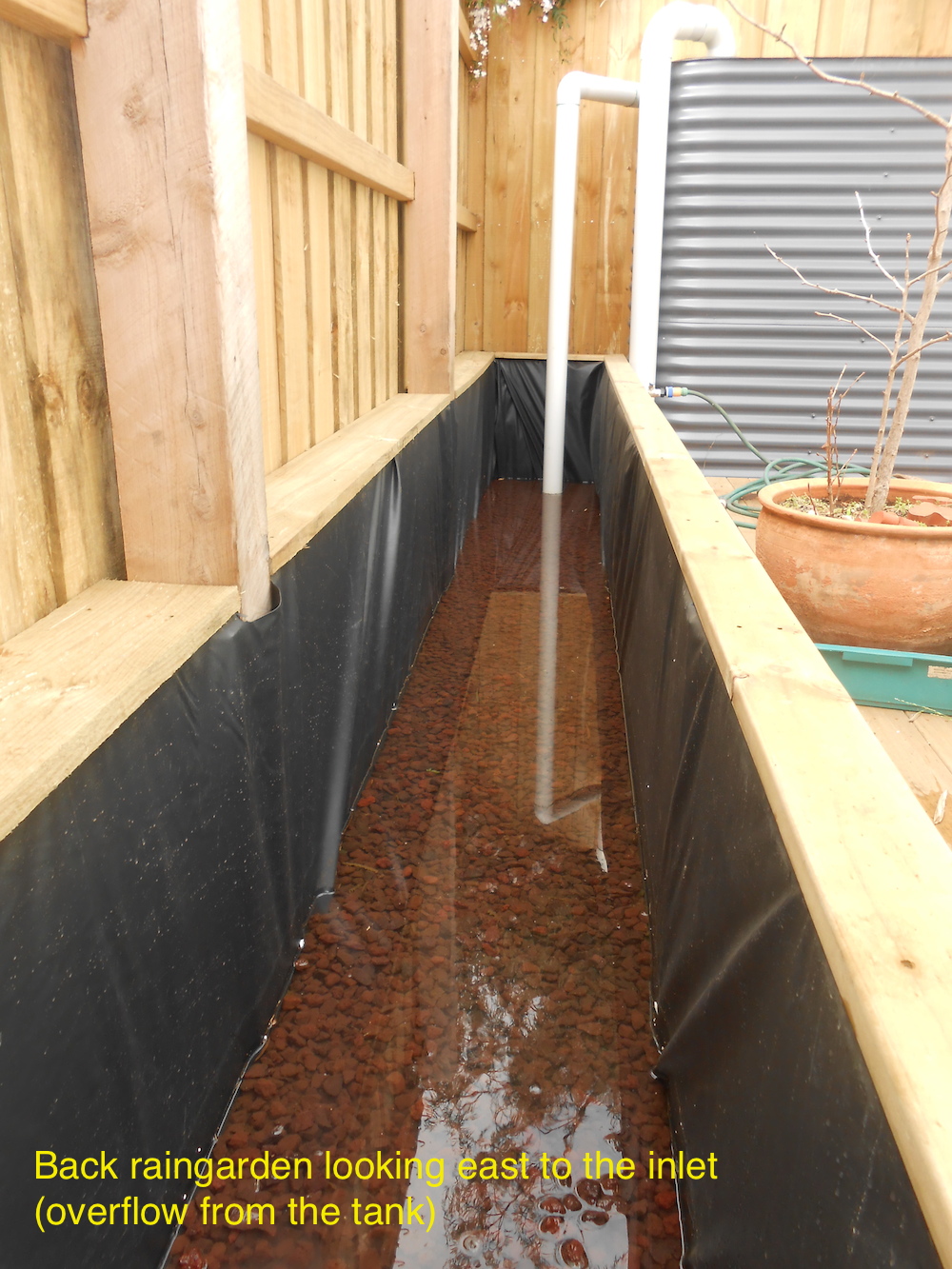
Wednesday 16 July, 2014: Back rain-garden complete and connected to tank (with the scoria layer over the slotted pipe, but leaving the transition and soils to me once we have moved back in), overflow to the front raingarden also connected, but front garden still just a hole in the ground (albeit with pond liner on its walls to prevent water soaking out laterally).
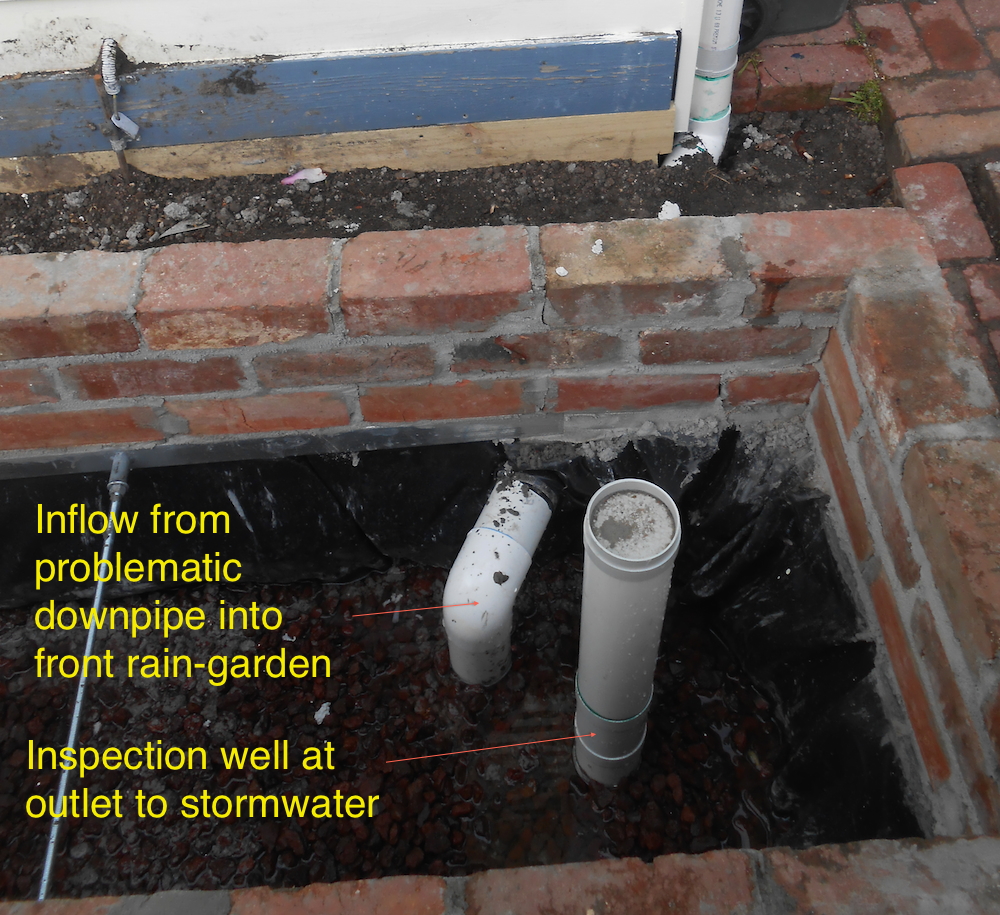
Wednesday 30 July, 2014: We finally moved back into the house today. In the last 2 weeks, without us using any water, the tank and the back raingarden have filled and water has flowed into the front garden. Fortunately the water drained out in time for the plumber and builders to arrive today to connect it. I caused the plumber some stress when I discovered that he had connected the remaining 4 m2 of roof straight into the stormwater outlet, and asked him to re-arrange it so that it flowed into the rain-garden (which he did with good grace).
Saturday 2 August, 2014: Some consternation and confusion. After 15 mm of rain yesterday and today, the front rain-garden filled and overflowed , but much to my surprise the level of water in the back raingarden has dropped by ~15 cm from the level of the outlet. My first thought is that it has sprung a leak, despite us not having touched it.
Monday 4 August, 2014: Pete at work made the interesting suggestion that it might not be a leak but some sort of strange siphoning behaviour. On going home and staring at the outlet for long enough, I managed to convince myself that that was indeed what had happened. With the two gardens full, the charged pipe between the two systems formed an air lock, which meant that the pipes siphoned water out of the back garden until the water was level with that of the (lower) front garden.
Wednesday 6 August, 2014: After getting advice on the right place to do it, I took to the outlet pipe in the back raingarden with a drill to make a small hole to break the air lock. It had been raining, and a little water had ponded in the cap on the inspection well. I drilled a ~1-mm hole in the middle of the cap…and nothing happened. The water just sat there in the cap. So, I drilled a second hole in the side of the inspection well, and suddenly the water in cap drained freely into the pipe. Air lock successfully broken!
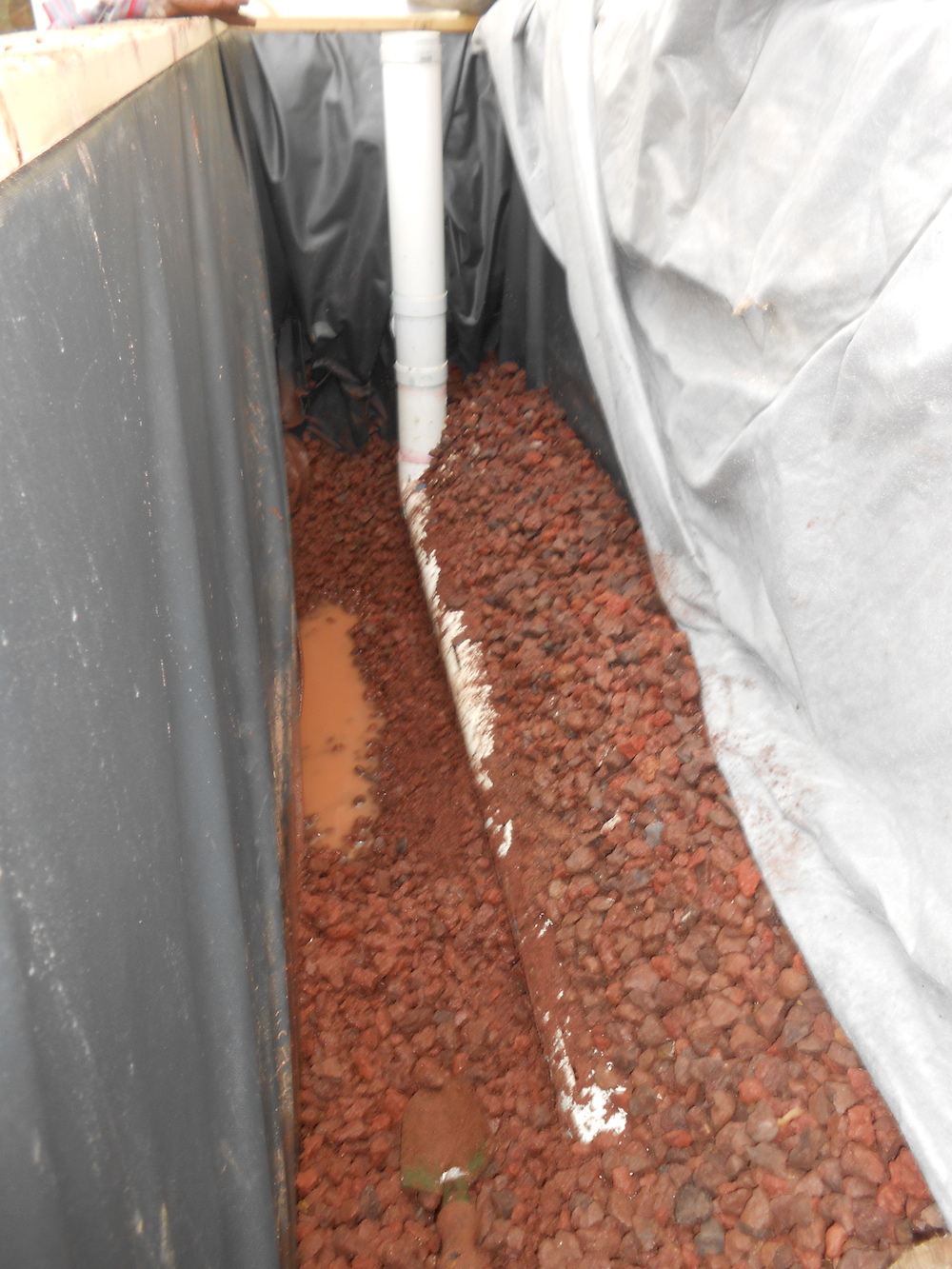
Saturday 9 August, 2014: The original plan was to lay a ~5-cm deep transition layer of finer gravel over the scoria, and a similar layer of sand over that to prevent the soil dropping into the gravel layer. But Tim at work suggested an alternative approach: just lay geofabric over the gravel and put soil right on top of that. He also suggested that I install geofabric wicks into the scoria layer to allow the soil to draw up water when the water level falls below the transition layers. So, I installed a trial wick with a roll of geofabric. It didn’t seem very absorbent and water did not rise along it, so I was dubious, and have asked for further advice.
Wednesday 13 August, 2014: Here’s a tip. While there are wicking geotextiles out there (for instance, here), not all geotextiles wick, and the polypropylene geotextile that I’ve been using doesn’t. My trial wicks were a waste of time, and I’ve resigned myself to digging out the scoria from sections of the raingarden to fill with soil to the bottom of the garden, to allow the soil to do the wicking. A job for the weekend.
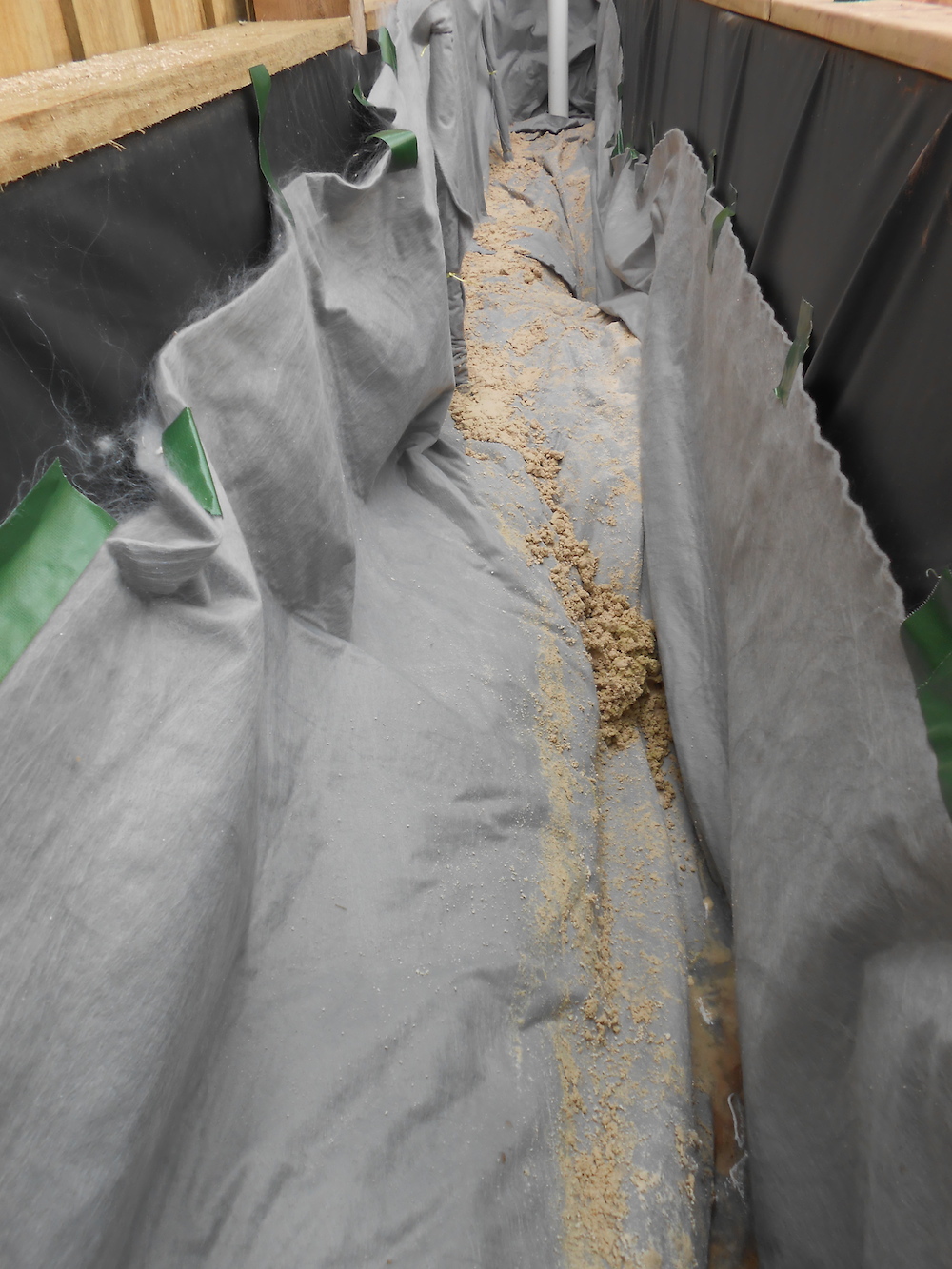
Sunday 17 August, 2014: Lots of scoria to dispose of now, as I emptied a good proportion of the back raingarden into the front raingarden (for the want of anywhere else to store it for now). To do this, I had to drain the raingarden with a small pump (into the fortunately temporarily vacant block next door). I now had two segments of the back raingarden empty to the base. I then laid the geofabric over the remaining scoria and filled the holes with as much sand-loam mix as I could muster without a bulk delivery to ensure the scoria remained stable in preparation for the next filling.
Thursday 21 Aug, 2014: At the pub last night, bumped into Phil Edwards, a fellow Richmond-ite, who has constructed a much more ambitious stormwater management system at his place, with an impressive green roof, and is also documenting its progress on the web. Here’s a link to Phil’s site.
Friday 22 Aug, 2014: I’m optimistic that the deep runs of sandy loam should do a good job of wicking. Today, after almost 2 weeks of virtually no rain, the surface of the sandy loam over the runs was tinged with green and feeling moist, in contrast to the dry white sand resting next to it on the geotextile, suggesting that the few cm of water I had left in the bottom of the garden was wicking up into the soil effectively. (The tank is down to ~one-third full now, and because I’ve emptied the back rain-garden (and will empty the front rain-garden tomorrow, we are going to need at least 30-40 mm of rain before the gardens fill up again…this is the sort of tank behaviour I was hoping for, so life is good…but a bit of rain would be good…)
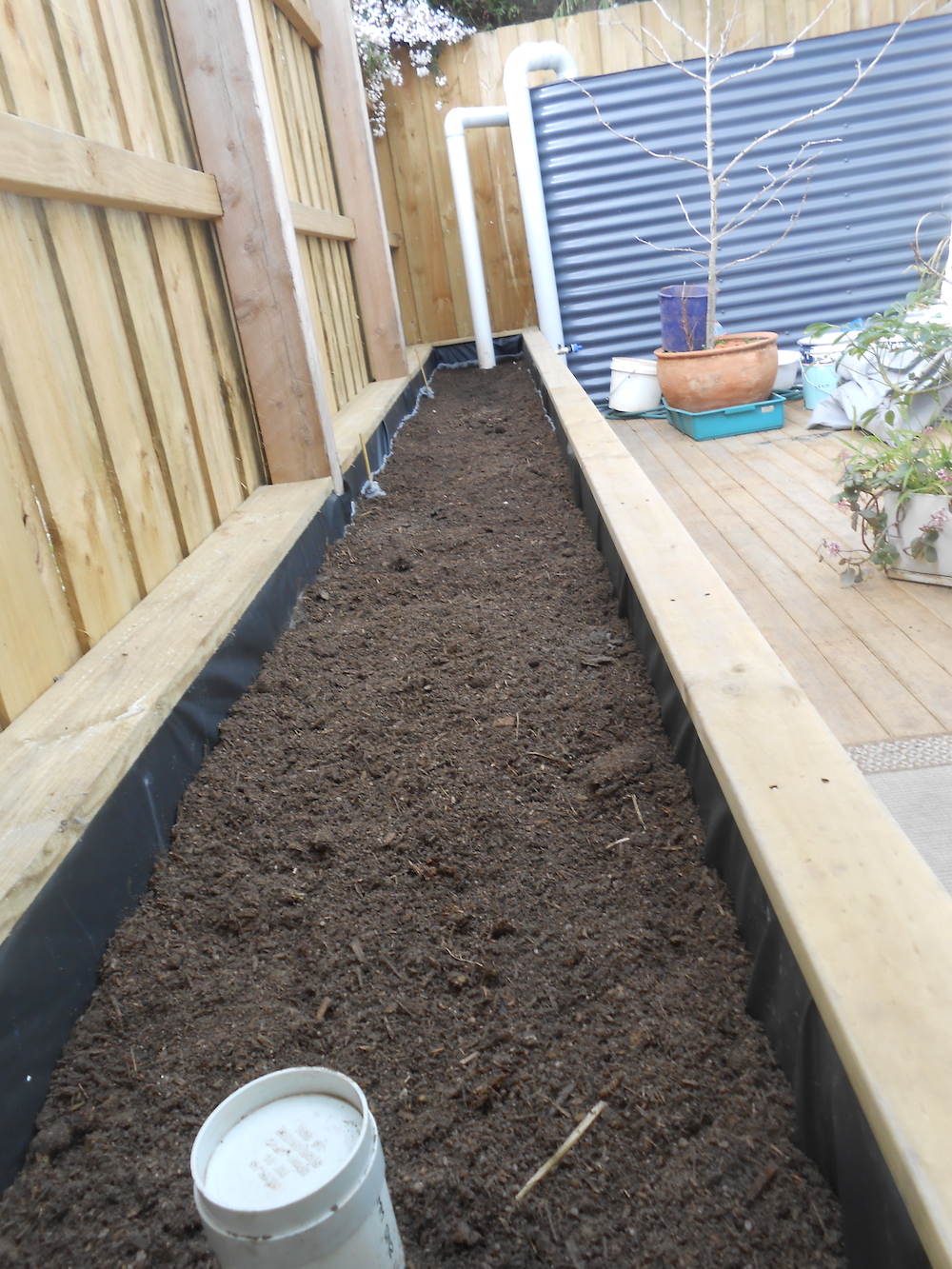
Saturday 23 Aug, 2014: 7:30 AM delivery of 2 m3 of soil (five-way soil from Fultons: just a typical soil/compost mix for a vegetable garden) followed by lots of bucketing through the house to fill the garden. I had optimistically hoped that 2 m3 would do the job for both rain gardens, but after compacting, it is clear that delivery volume is something like 1.5–2 times volume in the garden (so we’ll need a delivery of an additional cubic metre to fill the front garden, I’m thinking). Anyway, it’s now looking a million dollars, and ready to plant. Next: move onto the front raingarden (still full of last week’s excess scoria from the back raingarden).
Sunday 31 Aug, 2014: Following the delivery of another cubic metre of soil, both raingardens are now full of soil. Annoyingly the painters (who are taking forever to finish the outside of the house) came yesterday morning and trampled all over the front raingarden which compressed the soil by ~10 cm.
Part 3. First plantings, first floods retained.
Today, we planted the first resident in the back raingarden: not a typical raingarden plant. We have a 20-y-old pot-bound Gingko that we liberated as a seedling from the feet of its parents in front of the Old Geology building at the University of Melbourne in 1994. It is a sign that this renovation is our final settling place that we have decided to plant it permanently in our raingarden. Being deciduous, it is not going to serve the raingarden in winter by losing water, but it is of great sentimental value, so here it stays. I note that Gingkoes aren’t fond of saturated soils, but I am hoping that with >30 cm of soil above the ‘full-tide’ mark of the raingarden it should be happy with most of its roots in moist soil drawing up from the deeper saturated zones.
Monday 1 Sep, 2014: First significant rain for 17 days today (~16.8 mm at Melbourne Water’s Burnley gauge ~500 m to the SW, not quite filling the tank). The tank was full on 14 Aug, and since then we have had at most ~1 mm of runoff that would have added ~120 litres of water to the tank. This morning, before it started raining, the tank had space for ~2000 litres, meaning that in the last 17 days we have used ~2100 litres of tank water. According to the Environmental Benefit calculator, 4 people should have used 75.6 litres/day for toilet flushing, 105.9 litres/day for laundry, and (at this time of year) zero for garden watering – adding to 3085 litres for 17 days. Now given that we have used some of the tank water for garden watering (I estimate ~100 litres), then the EB calculator is possibly overestimating tank use for houses with water-efficient toilets and front-loader washing machines like ours.
Thursday 25 Sep, 2014: About 20 mm of rain last night (18 mm recorded at Burnley, and 23 mm recorded at Hawthorn ~ 1km to the east), following about 10 mm of rain in four or five smaller events since the rain of 1 Sep. Last night’s rain was enough to fill the tank, and to my surprise, the two rain gardens. There was evidence this morning that they overflowed to our stormwater outlet to the street (which drains to the kerb at street level, so moisture around the outlet is apparent when it has been flowing). It was likely to be only a small spill to the street, meaning that the system was able to retain close to 20 mm before discharging from the property, which is close to my design intention.
Monday 27 Oct, 2014: Our first big storm for a month last night. 20 mm of rain by 8:30 am this morning saw water flowing out of the property into the street again (27 mm fell in total). Definitely the first time the property overflowed since the previous post. 20 mm of rain fell between the last storm and this one, so the system has retained ~38 mm in the last 32 days (accounting for 0.5 mm of initial loss from the roof in each event), meaning that we (and the rain-gardens) have been consuming ~135 litres per day from the tank and gardens. As we have been using ~35 litres per day watering the plants in the gardens (to keep the surface soil moisture up for the short-rooted seedlings), this puts our use for toilet flushing and laundry at ~100 litres/day (similar to the usage I estimated on 1 Sep), substantially less than the 180 litres/day that the Environmental Benefit calculator estimates.
The rain-gardens are both now planted out with seedlings, all looking healthy, but still small, and not transpiring as much as they will.
Sunday 16 Nov 2014: Flood mitigation. Another big storm last night: 41 mm, and of course the system overflowed to the street (3rd time in 3 months, remaining on track for its design performance).
Some question the effectiveness of these sorts of systems at mitigating flooding, but let’s think about how our system performed last night. The tank had space for ~20 mm of runoff before the storm last night. This means that our property released ~20 mm of runoff to the street drainage. Now, 20 mm of runoff is generally not enough to cause flooding problems, but 40 mm? Yep, cars trapped in floodwaters in parts of Melbourne last night. If all of the properties in these (inner-city) parts of town had systems that retained similar volumes to ours, it stands to reason that flood damage could have been avoided. Of course systems like ours are not going to prevent all floods, but they can certainly reduce the frequency of damaging floods- and that is basically the name of the flood mitigation game.
Part 4. First summer, first harvest, more flood mitigation, the gingko finds its wet feet.
Tuesday 7 Jan, 2015: A summer update. A week or so after the last entry ~15 mm of rain was enough to cause the system to overflow again, but no further overflows since then: 4 overflows to the street drainage in a bit over 4 months. I estimate that about 35 mm of rain has overflowed to the street in those 4 events, which means the system has retained ~86% of rainfall since it started operating (with a full tank) in August. This is close to the performance I had hoped for, and it should improve as plants in the rain gardens grow.
We experienced 2 days of ~40°C on Friday and Saturday, which really tested the raingardens. But without any additional watering for over a month, none of the plants in either raingarden showed sign of water stress on these days. It seems that water is wicking well up into the surface soils, as even the smallest, recently planted seedlings have been happy. Here is how the back garden is looking now.

All of the smaller plants are thriving (from left to right: continental parsley, english spinach, oregano [small and slow growing, so only just visible], rocket [which we have allowed to go to seed with the aim of it self seeding: we have also planted a few chard seedlings amongst the ageing rocket], more spinach, coriander [also going to seed],dill, tomatoes, daisies, basil, and the Nelly-Kelly passionfruit vine being trained onto the trellis in front of the tank). We have been harvesting all of the leafy greens over the last couple of months, and the tomatoes are just beginning in this garden now. The gingko, on the other hand, is not looking super happy: the leaves began turning yellow a month or so ago, and brown spots have begun to appear on their edges. It seems that the advice we received that they don’t like wet soils was good.
The grapevine that we intend to plant in the raingarden has been growing fast in its pot, and is now ~2 m high. Come winter, we will transplant the grapevine into the raingarden (to grow over a pergola to provide shade), and we will put the gingko back in its pot (maybe a bigger one) to give it a happier, drier life. I aim to plant a Melaleuca in its place. We really like the Melaleuca that hangs over our back fence. It attracts heaps of native birds to our back yard (rainbow lorikeets, wattlebirds, white-throated honeyeaters, silvereyes, and the occasional currawong). But unfortunately it is likely to go next year as the house behind us is to be demolished to be replaced by yet another monstrous development. So I hope that our raingarden’s Melaleuca can, with time, replace that lost resource.
The front raingarden has also been going well. It receives the full brunt of the hot afternoon sun. Some of the leaves on the tomato plants burnt over the recent hot days, but no sign of wilting from any of its inhabitants. Here is what it looks like now.
The zucchinis in the foreground have been happy enough, but not one zucchini has grown larger than the little one you can see with the flower. I’m not sure what is going on there, but there have been no complaints from the family as we have an embarrassment of monster zucchinis from my plot at work. Behind the zucchinis are eggplant and basil plants (no sign of eggplant fruit yet). And behind them, tomatoes, and the blood orange and lemon trees. Both citrus trees have fruit growing on them, but have not been growing new shoots with great speed. We have been collecting a modest harvest of cherry tomatoes from this garden over the last week.
Water level in the back garden has dropped ~14 cm during the recent dry spell (and I expect the front garden has behaved similarly – it is less easy to measure). With the drop in water level, the level of the soil has dropped a few cm – we will need to top it up at some stage. The tank was very close to empty on Saturday, but the cool change brought 4 mm of rain, so we are yet to run out of water (and test our system that is supposed to switch automatically to the mains system when the tank empties).
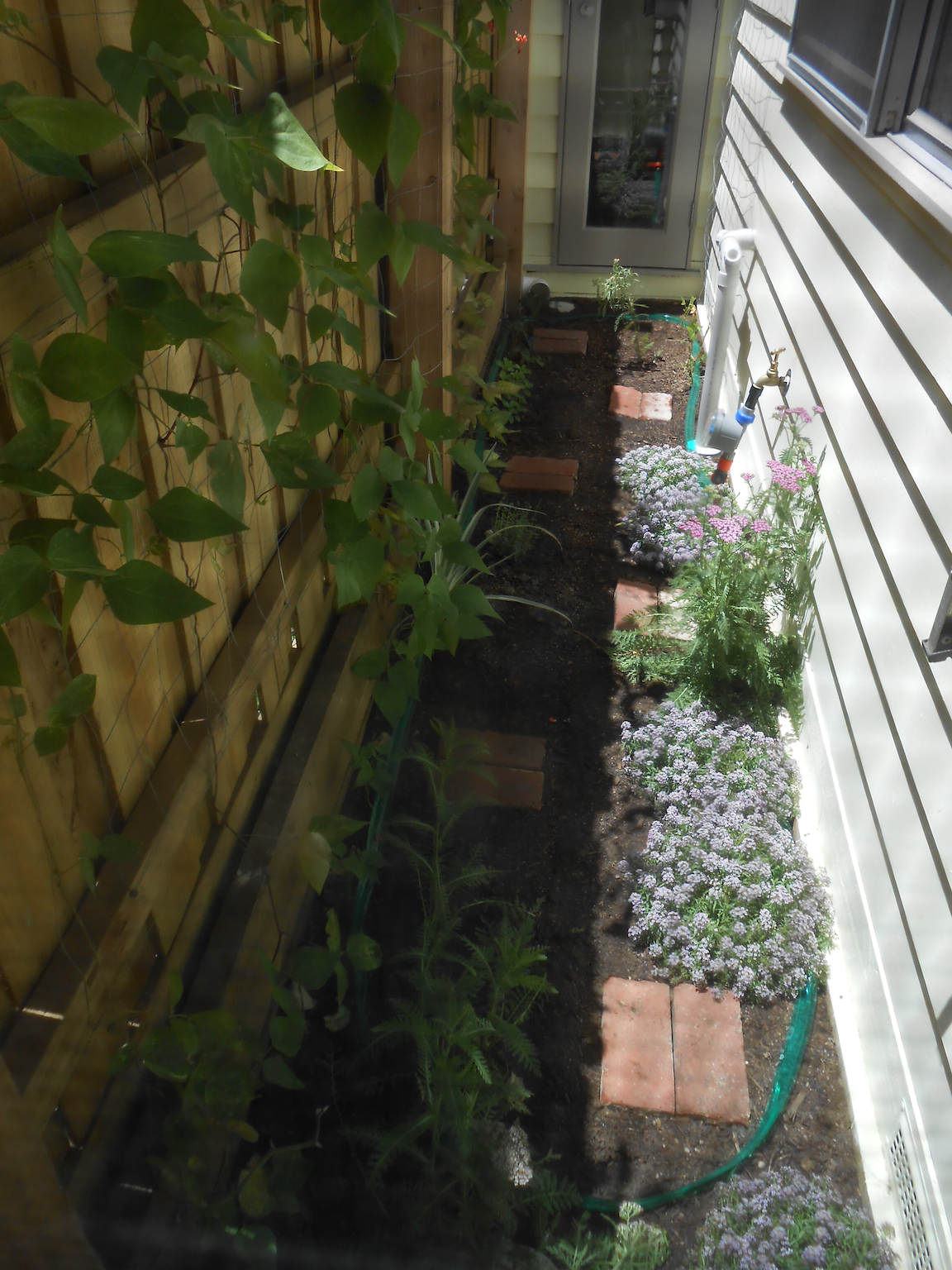
The tank of course has also been the sole source of water for our small garden outside our kitchen window. It is also growing well, with a crop of beans, mint, thyme and various ornamentals. Not a raingarden as such, but it’s an important water user that is contributing to the performance of the stormwater management system, so here is a picture of it, to be completist. The drip irrigation system is fed from the rainwater tank.
Wednesday 7 January 2015: Flood mitigation part 2.
Another data point to battle the naysayers on the flood mitigation benefits of stormwater management systems like ours. 21 mm of rain in a series of thunderstorms this afternoon. Not quite enough to fill the tank and still a fair bit of capacity in the two raingardens. So, zero runoff from our property, but just 500 m south in Toorak, and a few km down the road in South Yarra, roads flooded. Lots of rain forecast over the next few days, so I’m expecting an overflow sometime soon, but so far since November, widespread adoption of systems like ours would have prevented 2 out of 2 urban flooding events in the inner city.
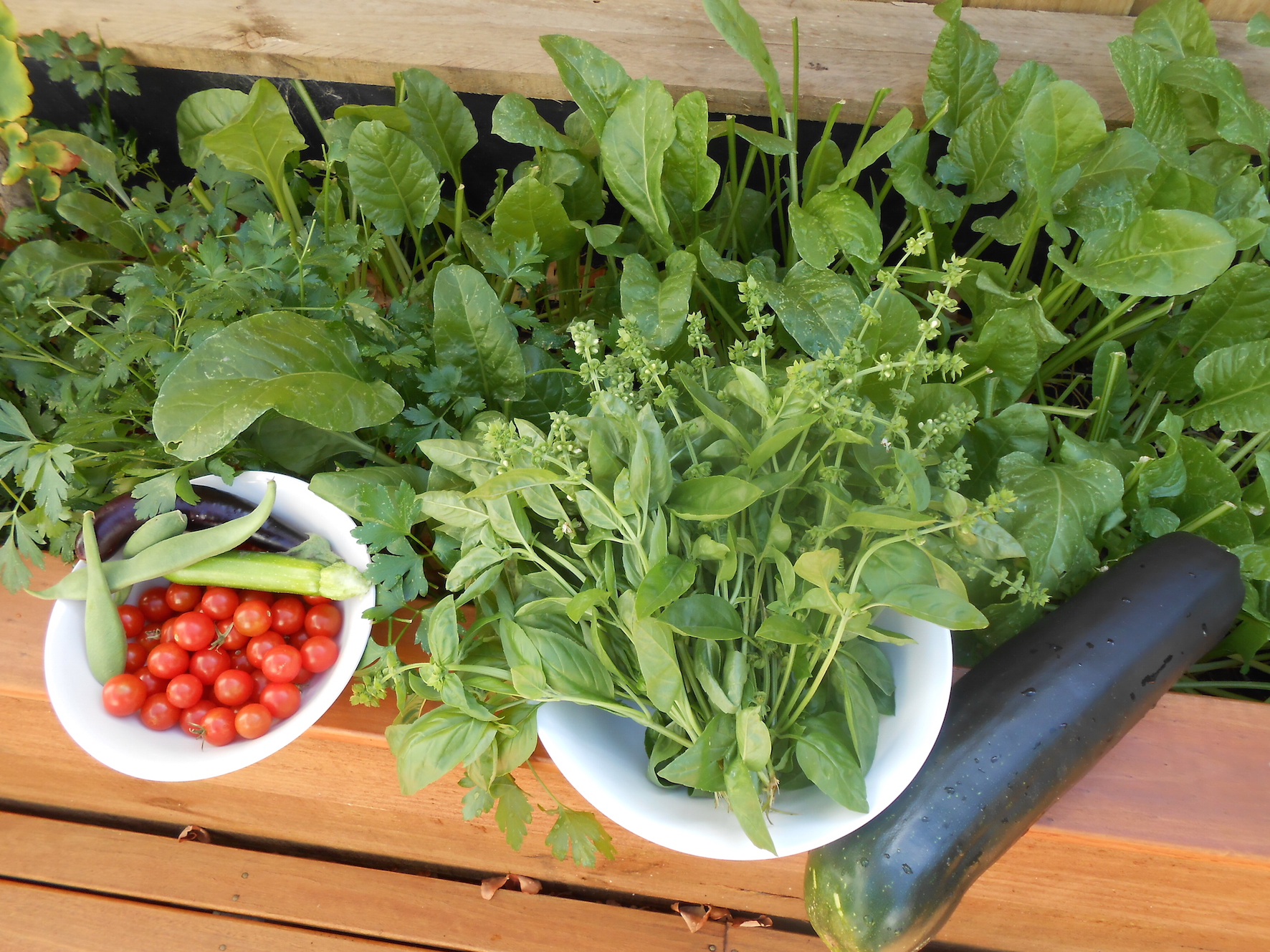
Sunday 1 March 2015: Harvest.
I haven’t watered either of the raingardens since last September, but they have been quite productive, relying on their water reserves. Since December, we haven’t had to buy tomatoes, basil, spinach, parsley or oregano (saving ~$10 per week). Here is today’s harvest (next to the parsley and spinach bed). The basil from the front garden (picked and pictured in the bowl) has started to flower, but no sign of flowers in the basil or spinach in the back raingarden as yet. In an earlier post, I rued the tininess of the zucchinis in our front garden, but I found the monster in the photo lurking behind the raingarden wall this morning…zucchini pasta coming up this week.
The gingko has made a late season comeback. After looking sick for most of summer, in the last few weeks, as the water level has drawn down in the raingarden, it has sprouted some new leaves that are looking healthy (despite the soil level dropping by ~10 cm over summer as well). The lemon tree in the front garden has done the same thing. This makes me think that if I can sit the trees a little higher in the gardens they might be happier. So, in 2-3 months, I will add more soil to the gardens to raise their levels and I’ll build some boxes for the three trees (lemon, orange and gingko) to sit ~30 cm higher than the rest of the garden surface. We shall see.
Friday 3 April 2015: First emptying of the tank
Our tank has finally emptied today and our system has automatically switched from the tank to mains. This is the first time the tank has emptied since we began using it almost 8 months ago. The tank was full 34 days ago (1 March) when we received 17 mm of rain: not quite enough rain to fill the two raingardens and cause an overflow to the street. Since then we have had 5 rain events >0.5 mm, that produced 6.5-7 mm of runoff (810–880 L) into the tank. So in 34 days we have used 3,500–3,575 L: a little over 100 L/d from the tank (remarkably similar to my earlier estimates, above).
Over the same time, the two rain-gardens have dropped about 250 mm (260 mm in the back, 250 in the front, which receives a little extra runoff from part of the roof). If we account for the void space in the gardens this is nearer 150 mm of evapotranspiration loss (~20 L/d), somewhat less than the 210 mm of evaporation recorded at Melbourne Water over the same time. Understandable, as both gardens are shaded for at least some of the day. Although this loss should increase as the passionfruit vine grows (steadily increasing its cover over the tank where it receives plenty of afternoon sun), and increase further when we plant the grapevine and it starts growing over the courtyard next summer. Both gardens have plenty of water sitting in them still (~10 mm in the front, and ~30 mm in the back), and the soil continues to wick well, as the plants all remain happy without any manual watering.
From a reliability perspective, the tank has been more reliable than I expected, providing water on 99.5% of days. As it happens, we are going away for a week tomorrow, during which at least a few mm of rain are forecast. That should be enough to keep us going until the forecast autumn rains, meaning that we will only have gone without tank water for 1 day in 1 year.
From a stormwater management perspective, the system is performing very well. It currently has capacity to retain at least 27 mm of rain. Since the system began operating, it has overflowed to the street 5 or 6 times in 8 months, which is close the performance predicted by the Environmental Benefit calculator, even though the calculator does seem to overestimate our demand for water.
Part 5. A year in: increasing our water demand, lifting the trees higher, plenty of water through a dry spring and summer
Saturday 25 April 2015: Increasing our demand for (tank) water
A rainy saturday at home and the tank is heading towards full again for the first time in over a 100 days. Housebound, I’ve been causing my family some consternation, as I’ve been fiddling with the cisterns of our two toilets to turn off their ‘half-flush’ setting. Now every press of the button produces a full flush (which is still only about 5.5 L). This should increase our demand from our tank by 20–25 L a day. “It just doesn’t seem right!” was the chorus from the family, as it goes against everything our water authorities tell us about conserving water.
This sure is a difficult concept to get one’s head around, but increasing our demand by a little each day should make the raingarden and tank system perform better, with negligible effect on our usage of mains water. After eight months of operation, through a reasonably dry summer, the tank has proved to be an extremely reliable supply (see the last post). It is highly unlikely that the tank will empty again until next summer, and even then, the additional half-flush demand per day is only likely to leave us without tank water for a few additional days per year, potentially increasing our draw from the mains by a few hundred litres (compared to the >40,000 litres a year we are saving by having the tank in the first place). At the same time, increasing the demand on the tank water by 7–9,000 litres per year (20–25 litres per day), should have a large effect on the frequency with which the system overflows.
So by disabling the half-flushes on our toilets, we are doing our local river more of a favour, at negligible increased cost to our broader water supplies. If we are going to start reducing our urban stormwater impacts on our rivers and streams we are going to have to move beyond our single-minded focus on reducing our usage of water. The trick is to maximise our use of stormwater, and minimise our use of water from our mains supply.
Sunday 26 April 2015: A case in point
So, we’ve had about 20 mm of rain since yesterday, and at 10:40 this morning, the system began overflowing to the street.
Now that overflow (the first of the year) comes 23 days after the tank was empty on 3 April. 45.1 mm have fallen in Burnley since then, which probably resulted in something like 39-41 mm of runoff (estimating initial loss is an inexact science). We have been home for 15 of those 23 days, and have probably used ~1,650 L in that time (= 13.2 mm of runoff), so my estimate of the system having about 27 mm of storage back on the 3 April was in the right ballpark.
Only the last 2–3 mm of today’s rain ended up overflowing to the street. If I had switched our toilets to full-flush-only on 3 April, then we would have used ~300 L more tank water by now, equating to 2.4 mm of runoff. So, full-flush only would have prevented today’s small spill of runoff to the street. Use more tank water!
Sunday 13 June 2015: Ten days of enough rain to cause roof runoff in the 6 weeks since my last entry. The rainiest day was the 10 May, in which 11 mm fell, which was just enough to fill the system again. Three of the following 4 days had more than 2 mm of rain, so I am sure that the system would have overflowed on each of those days. In 6 weeks in which 70.4 mm fell in Burnley, the system has let ~10 mm flow to the street over 3 days. So, now after 10 months, the system has overflowed on ~10-11 days. Not quite as good as I had hoped, but future performance is likely to be better now with our water guzzling toilets and, soon, once I have raised the trees in the rain-gardens and plant the grapevine to allow it to grow over the back courtyard.
Sunday 12 July 2015: A short note to keep track of over system overflows. The system had begun overflowing by midday today. 29.4 mm of rain has fallen at the Burnley gauge in the 31 days since my last entry (until the system overflowed). Assuming a 0.5 mm/d initial loss (which I think is an overestimate), this equates to 20 mm of runoff. So, for the system to be overflowing already, it seems our water usage is lower than it has been (more like 80 L/d than 100).
Saturday 5 Sep: We had another cubic metre of soil delivered today – all plants ripped up out of both gardens and the level of the soil raised to near the top in both gardens. And as planned, the two citrus trees at the front (the lemon tree looking most unwell) and the gingko and the newly installed grape vine at the back raised in their own containers above the level of the rest of each garden (hopefully to allow them more room for their roots above the saturated layer). We shall see…
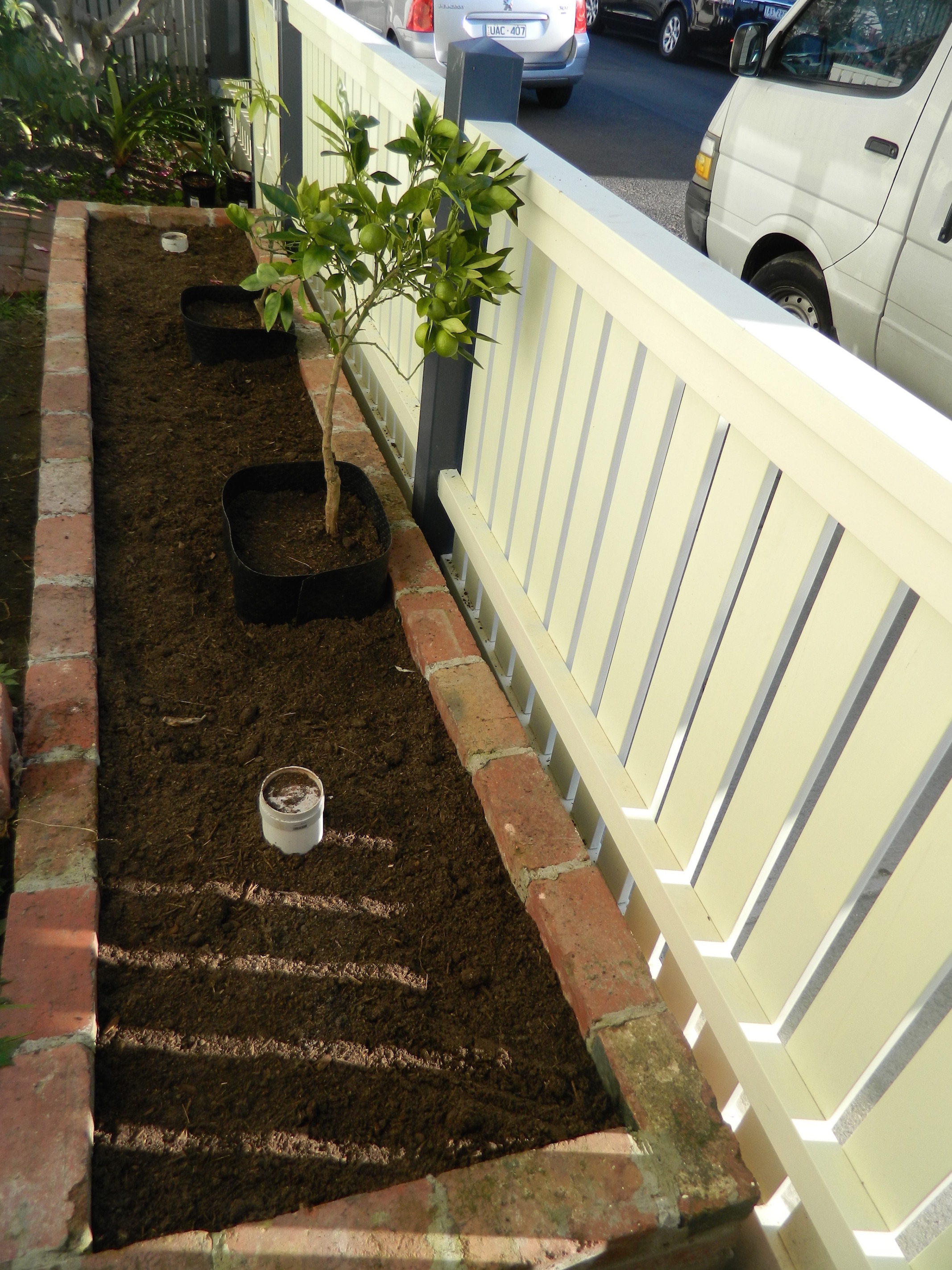
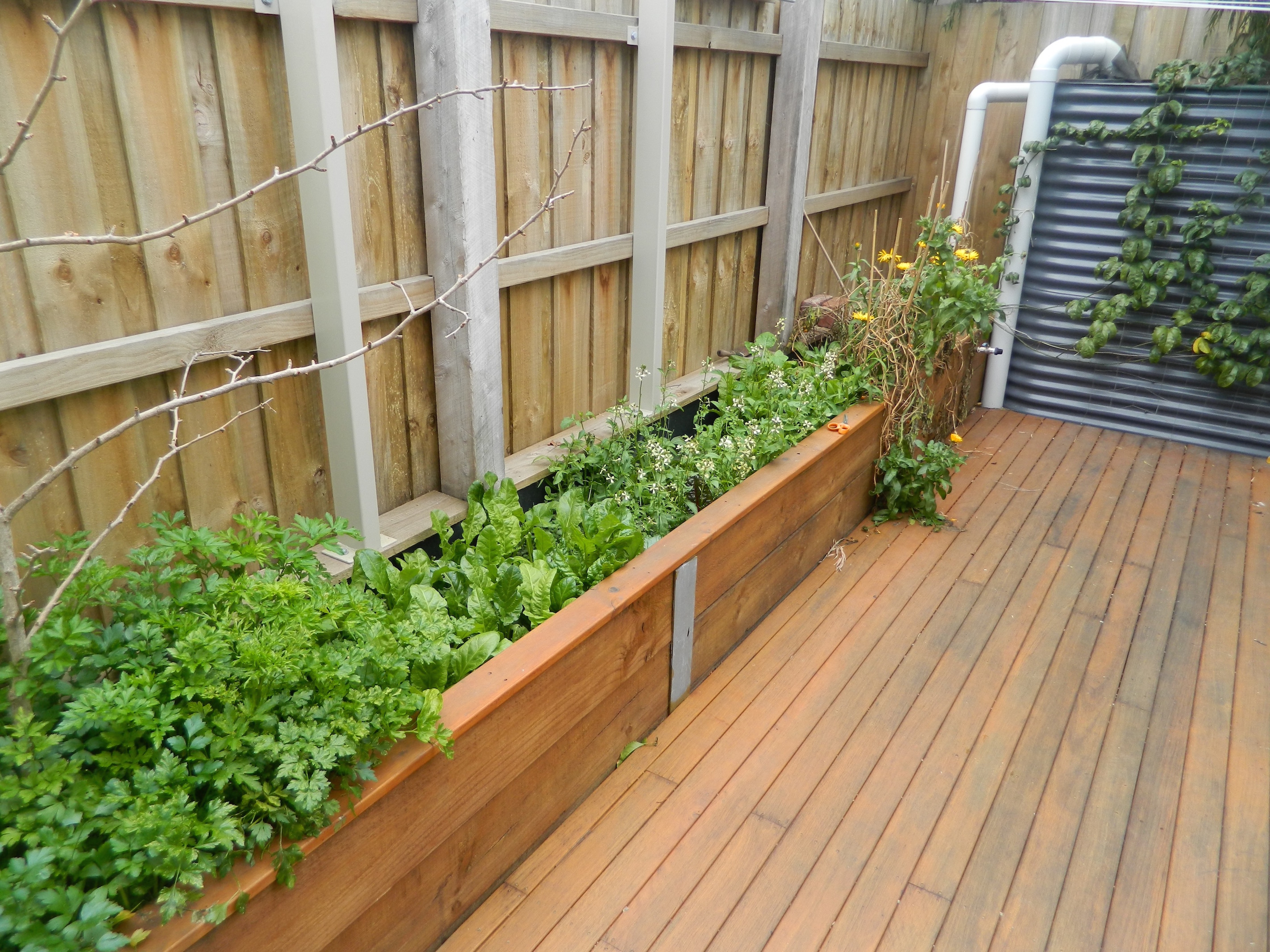
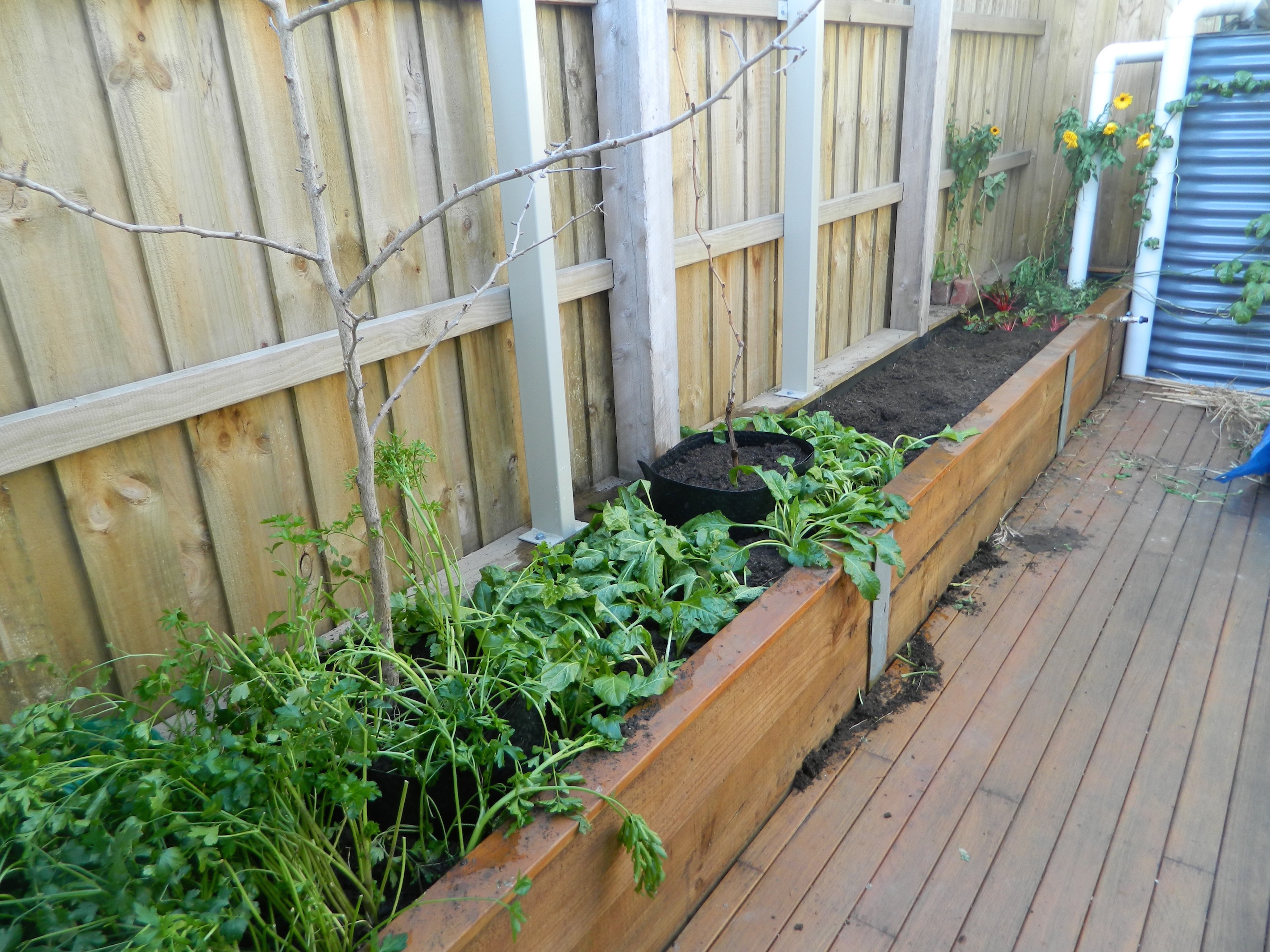
14 October 2015. El Nino bites. So, the Indian Ocean Dipole collapsed suddenly in September and all of a sudden the threatened severe El Nino has made its presence felt. The tank was full on 15 September, and since then, we’ve had 1 day of 4.8 mm of rain (22 September) and 6 other days of any rain, but the wettest of those was 3 days with 0.6 mm. So, in a month, we have probably received ~550 L of inflow into the tank: allowing for say 100 L remaining in the bottom of the tank, that means we have used 3,150L in 30 days – a bit more than we used to – but probably not entirely down to my half-flush hacking – we had 10 days of 2 visitors increasing our household population by 50%. Maybe up to 4 mm of rain forecast in the next few days which might get us back into the tank water, but for now, no sign of the tank filling again for a while. Who would have thought, in October?
Nevertheless, plenty of water remaining in both rain-gardens, and the gingko, the lemon tree, the orange tree and the new raingarden inhabitant, the grapevine are all looking happy. I have veggie seedlings growing in the nursery at work ready to plant in the next few weeks.
25 October 2015. The tank received about 8 mm of runoff on Wednesday, and we back using tank water again. The 8 days of emptiness spurred a little rant on the importance of yield over reliability here.
13 November 2015. Taking the nerdiness of this site to the next level, I’ve recently discovered the rainfall data on this site* at the Burnley campus of the University of Melbourne, 500 m from our house. I’ve downloaded the 6 minute rainfall data recorded since it has been operational (23 Oct), and done some estimates of when and how much water we use each day to estimate the proportion of runoff that we are keeping on our property. So, in the last 3 weeks (which included a big rain event of 40 mm over 3 days, 48 mm in total), our system has retained 77% of the runoff on our property (1,300 litres released to the street of 5,650 litres that fell on the property: 2 days of runoff from the property out of 6 days of runoff from the roof (9 mm on a day of 19 mm rain, and 1 mm runoff on the following day of 2 mm rain).
(*Nah..it was too nerdy: a record every minute was way too much data for me to play with…they’ve subsequently changed the url of the system, so I have removed the link)
10 April 2016. Our raingardens and harvesting system feature in the latest issue of ReNew Magazine. Ironically, this issue (No. 135) is subtitled ‘The Water Saving Special”, while the biggest challenge for our system is to use enough of the large volume of water that our house produces.
Even with the gardens growing amazingly over summer, the water they have used since the start of this drier- and warmer-than-average year hasn’t been enough to keep the tank from overflowing. The increased summer thirst of the gardens has increased our background use of captured roof water from ~100 to ~115 litres per day. In the 100 days since 1 January, our roof has produced 12,945 litres of runoff, and we (and the raingardens) have used 11,500 litres (about 89% of all runoff).
But the system overflowed at the end of January when we received ~24 mm over 3 days (about 9 mm of this flowed out to the street and to the river). The system could have captured all of this (and protected the river) if we used ~10-15 litres more water each day. I’m hoping that the grape and passionfruit vines will grow enough next year to increase our summer usage by about this much. With similar (low) rainfall, the gardens will have plenty of water to keep thriving, while providing that much more protection to the Yarra down the road.
So, yes, we are saving (mains) water with our harvesting system, but saving our local river means our gardens need to use as much (roof) water as possible. It certainly is a strange, counter-intuititive message I find myself shouting from the rooftops.
Part 6. A 2-year performance stocktake, early days for the grape and passionfruit vine
1 May 2016: A stocktake at the end of a year of improving performance. As the tomato plants decline in the raingardens, and winter shade descends across the back raingarden, I’ve taken the time to summarise the performance of the system over the last year (in terms of how often, and how much runoff we have allowed to overflow to the council drainage system). The plot on the left shows the volume of runoff that overflowed to the street and that was retained on the property each month over the last year. The plot on the right shows the number of days when any runoff was produced on the property, split into those days when all of it was retained on the property, and those days when some of it (some days very little) spilled to the street.
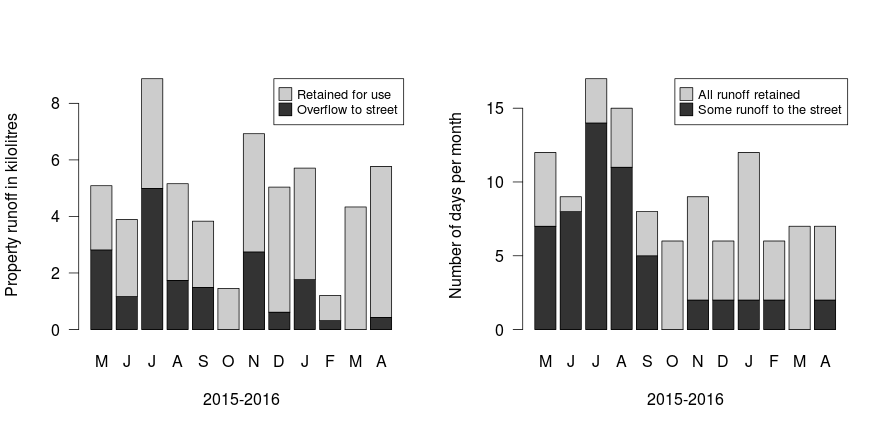
The system seems to have improved in performance markedly since last September. From May to September, we only retained 55% of runoff on our property, and on most days that it rained at least some runoff overflowed to the street. But from October to April, we have retained 85%, and we have had some overflow to the street on only 10 out of the 53 rainy days in that time. Although you might think this difference is a result of the drier weather over summer and autumn, that’s only partially true. Average monthly runoff volume from May to September was 5370 litres, while for October to April it was not hugely less (4350 litres), and most of the difference was attributable to a wet July. The main difference is the increased demand of the raingardens as their plants have grown and have had more sun time to use the water in the gardens.
The demand of the raingardens will decline again over winter, so it will be interesting to see if winter performance in 2016 is better than in 2015. It could be: the passionfruit vine made it to the pergola having worked its way around the eastern back fence and the southern wall of our house, where it will get lots of winter sun.
12 March 2017: An end of summer update. I will leave it for another couple of months before doing a stocktake similar to last year’s. It was a particularly wet winter, spring and early summer last year (average rainfall over 2 mm/d, more than 1 mm/d greater than our background demand to date), so the system overflowed a lot, and spent most of its time more than half-full. Well, that’s my feeling- I’ll let the numbers speak for themselves in a couple of months.
But the last month has been very dry. The system was full on 7 Feb (after a dump of 37 mm), and there has only been 9.4 mm rain since then. The tank emptied on 8 March, which works out at about 1.2 mm/d, or about 140 mm/d demand from the tank (up somewhat on last year) plus losses from the raingardens. And they have been picking up their demand as well.
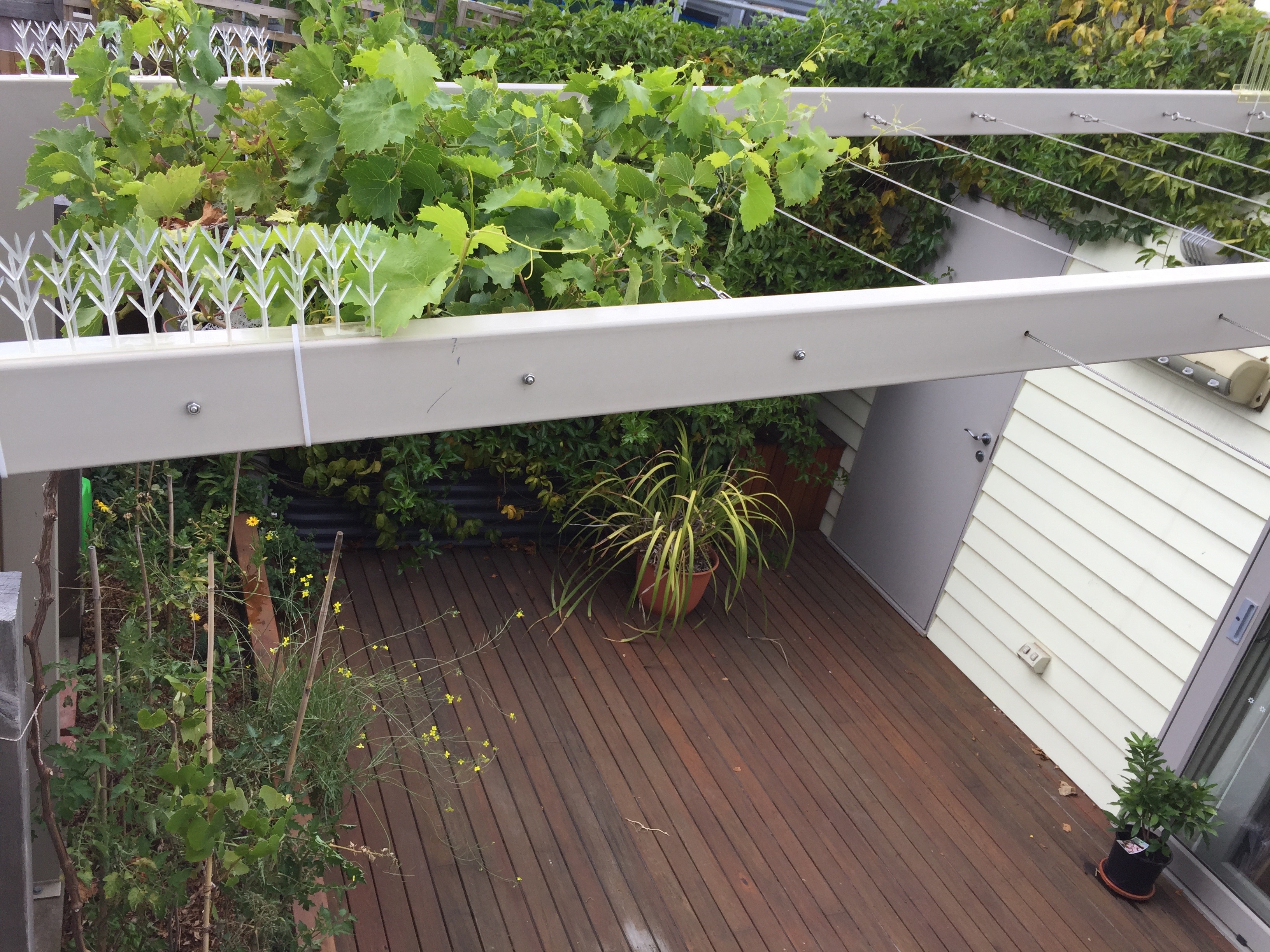
The passionfruit vine has continued to spread along the house providing shade and cooling, but disappointingly not a passionfruit to harvest as yet. And after a bad year last year when I thought that the grapevine and the gingko were not coping with the raingarden, they have both rebounded this summer. I think the grapevine’s unhappiness last year was a result of possum-grazing, but this year I have surrounded the pergola with anti-possum spikes, which have kept them away, and let the grapevine spread its tendrils. It even gave us a couple of sad little bunches of grapes (looked pretty average, but actually tasted ok), which I take as a hopeful sign for the future. The grapevine has made its way across about a fifth of the pergola. Perhaps next year it will provide substantial shade to our courtyard and house.
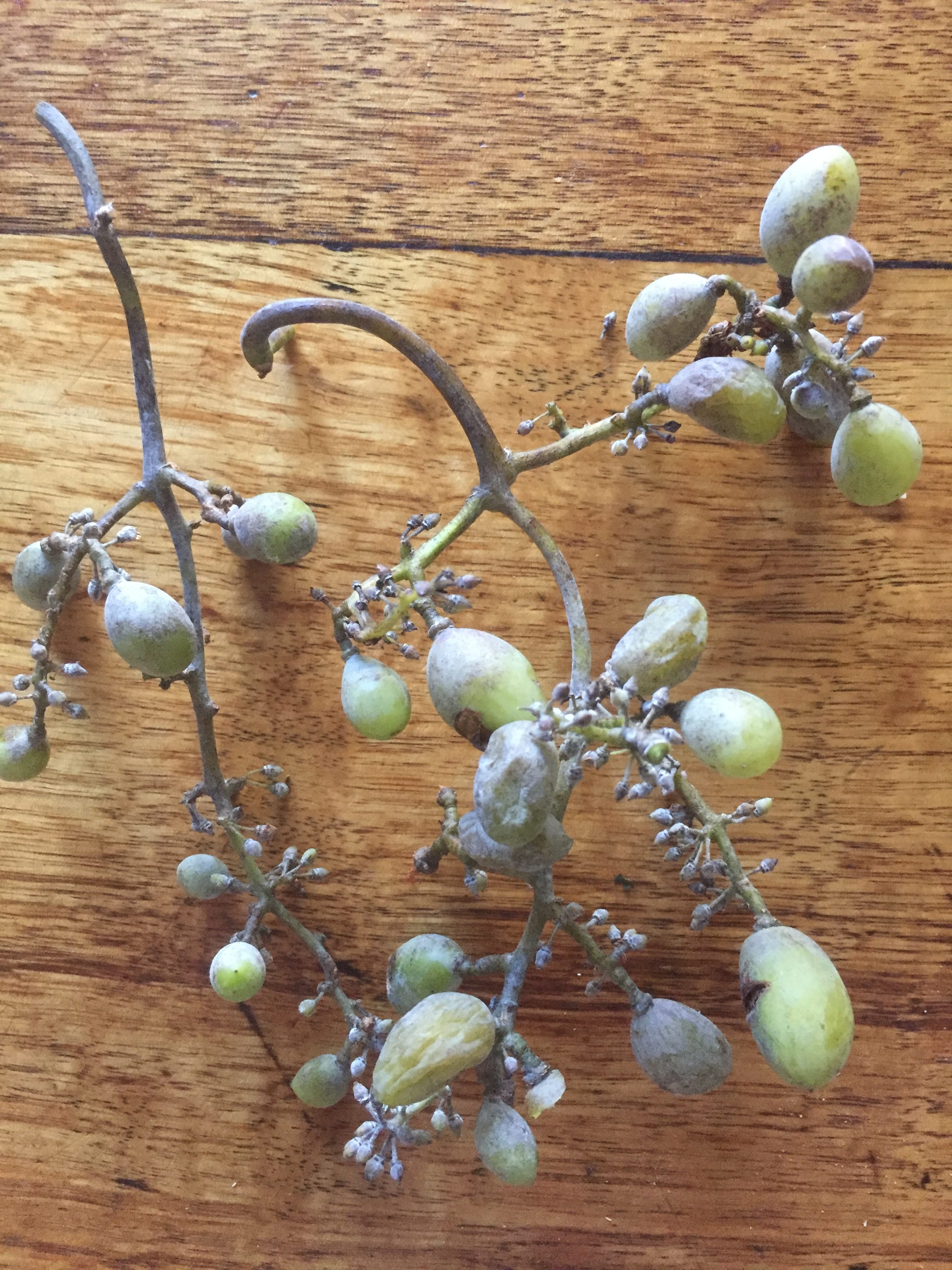
Otherwise in the back garden it has been a good year for parsley, genovese basil, spring onions, thyme, mint, oregano, tarragon (meeting all our needs since the new year), and gerbera and daisy. Not so good for tomatoes (not enough sun?), thai basil (got a brown spot) and spinach (after two years of a constant supply of tasty spinach leaves, the plants went to seed: one set of replacement seedlings did not survive, and the second set are growing slowly a month after planting). The added area of vines don’t seem to have massively increased its thirst: over the last dry month, the water level in it has tended to drop ~1 cm/d.
In the front garden, it has been a bumper tomato harvest after a slow start. Others in the street have been complaining that it has been a bad tomato year, but we have been harvesting ~500 g of tomatoes per day since early February (cherry and yellow pear so far, although the first roma was picked today). The garden also has some healthy basil plants and a strawberry plant is spreading beyond the garden (but is yet to give us a strawberry). The front garden has been thirsty. I have topped it up with a few hundred litres from the downpipes twice now (the second time this morning after 0.2 mm of rain, as the water level had sunk to below the bottom of the inspection well.
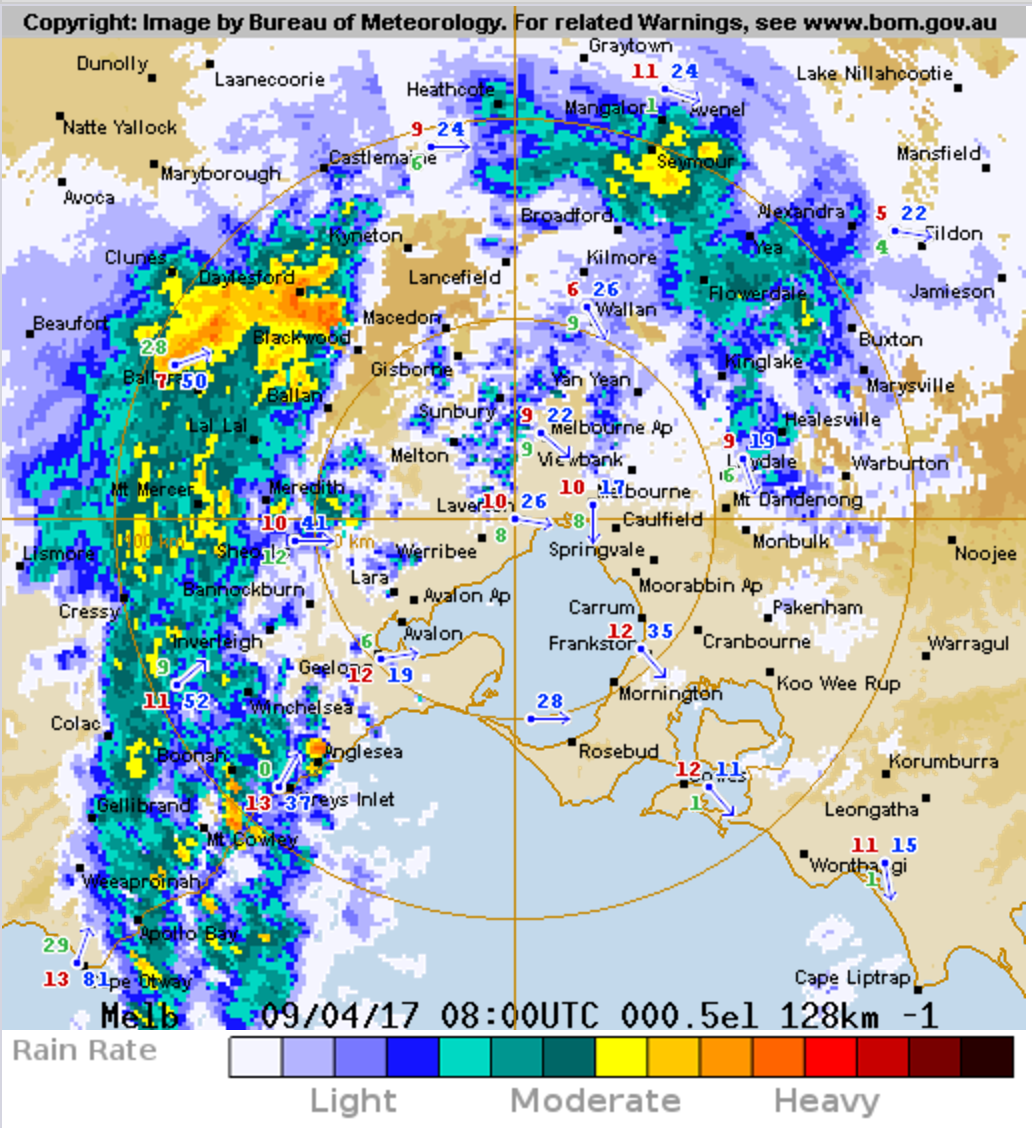
Neither garden has needed any augmentation from tap water, although with no rain forecast for the next week, the front garden may need some help next weekend.
16 March 2017: I looked beyond our property today to find our river suffering from a tiny amount of rain, leading to a related rant in my ‘News and Digressions’ blog. A little rain, a lot of disturbance.
9 Apr 2017: A rainy day in Melbourne. Our house is just to the right of Melbourne (at the top of the bay) in the Bureau of Meteorology rain radar image on the left, and that impressive rain system has been circling us all day. We reached 20 mm of rainfall at 5:15 pm this afternoon, and that was around the time our raingarden system started overflowing to the street. This is the first overflow since 5 February when we received 37 mm. In the intervening 63 days, between overflows, we have retained 62 mm of rain, so something close to 140 litres per day (accounting for the 10 days the tank was empty): a very close match to my estimate on 12 March (and a close match to 100 L internal use + 40 L in the raingardens).
Part 7. Years 3, 4: coping with heavy rain, cleaning out the charged downpipes, stormwater fed quail eggs, decline of the passionfruit vine, possum (1) v. grapevine (0)
19 Dec 2017: I’ve been saving up an annual review entry for the summer holidays, but tonight’s storm was impressive enough for me to break my diary drought with a quick report. The thunderstorm that rolled through this evening dumped ~17 mm on Burnley in about as many minutes. The water was pouring out of the pipe into the tank at an extraordinary rate, but the inlet of the tank coped with the inflow no problems. The downpipes on the house, on the other hand, did not: it seems the rain was intense enough to exceed the capacity of the charged system, and water was cascading over the rainhead on the down pipe with the biggest catchment (and to a lesser extent from the one with the next biggest catchment). The tank received about 11.7 mm of runoff, so we lost about 5.5 mm to overflows. But, none of this drained to the street, as the downpipes overflow to gravel paths, which soaked up the overflow (after a bit of ponding). So, all in all, I’m happy with the performance of the system in this intense event (another big storm that caused widespread urban flooding, but no runoff at all from our property). And I’m increasingly happy with the overall performance of the system, as I will explain in my summer-break entry…
11 Feb 2018: I didn’t get around to my summer-break entry: the stocktake of performance will have to wait. However, today, I finally got around to flushing out the downpipes in our charged system. I documented how I did it here.
28 Oct 2018: It’s been a long time between diary entries, and I still haven’t got around to doing a quantitative stocktake of the raingarden performance. Nevertheless, the system has been working extremely well (hydrologically) this (admittedly dry) year: it has only overflowed to the street twice all year, and the tank was empty for a total of 6 days. Neither raingarden emptied at all, but that was because I topped the front one up three times from the downpipes, and back one once from the tank.
From a food production point of view the raingardens have continued to feed us well, although the tomato crop was small this year compared to last. We harvested a good 5 kg of grapes from the grapevine on the pergola.

We have augmented our raingarden crops by converting our side-lane garden into a quail coup. Our four quails provide all the eggs we need, keep us entertained with their politics, and provide a bug-reduction service when they have day-outings in the back raingarden. We feed the quails about 40 kg of grain that we buy each year, but otherwise the ~1300 eggs they produce (~300 chicken eggs) are a product of our food scraps, off-cuts from the raingardens and tank water: so not entirely stormwater derived eggs, but at least partly.
But it hasn’t been all good news. Despite displaying rude health (a couple of years ago) on the front cover of the latest Renew magazine, the passionfruit vine has been looking increasingly ill over winter: a depressing contrast to the rude health it was displaying a couple of years ago. I was on the verge of pulling it out, but with spring it seems to have rediscovered a will to live, so we’ll see how it goes over summer. Sash at work, who know about such things, did say that passionfruit vines do only live for 7 years, so at 4 years old, it might just be getting long in the tooth.
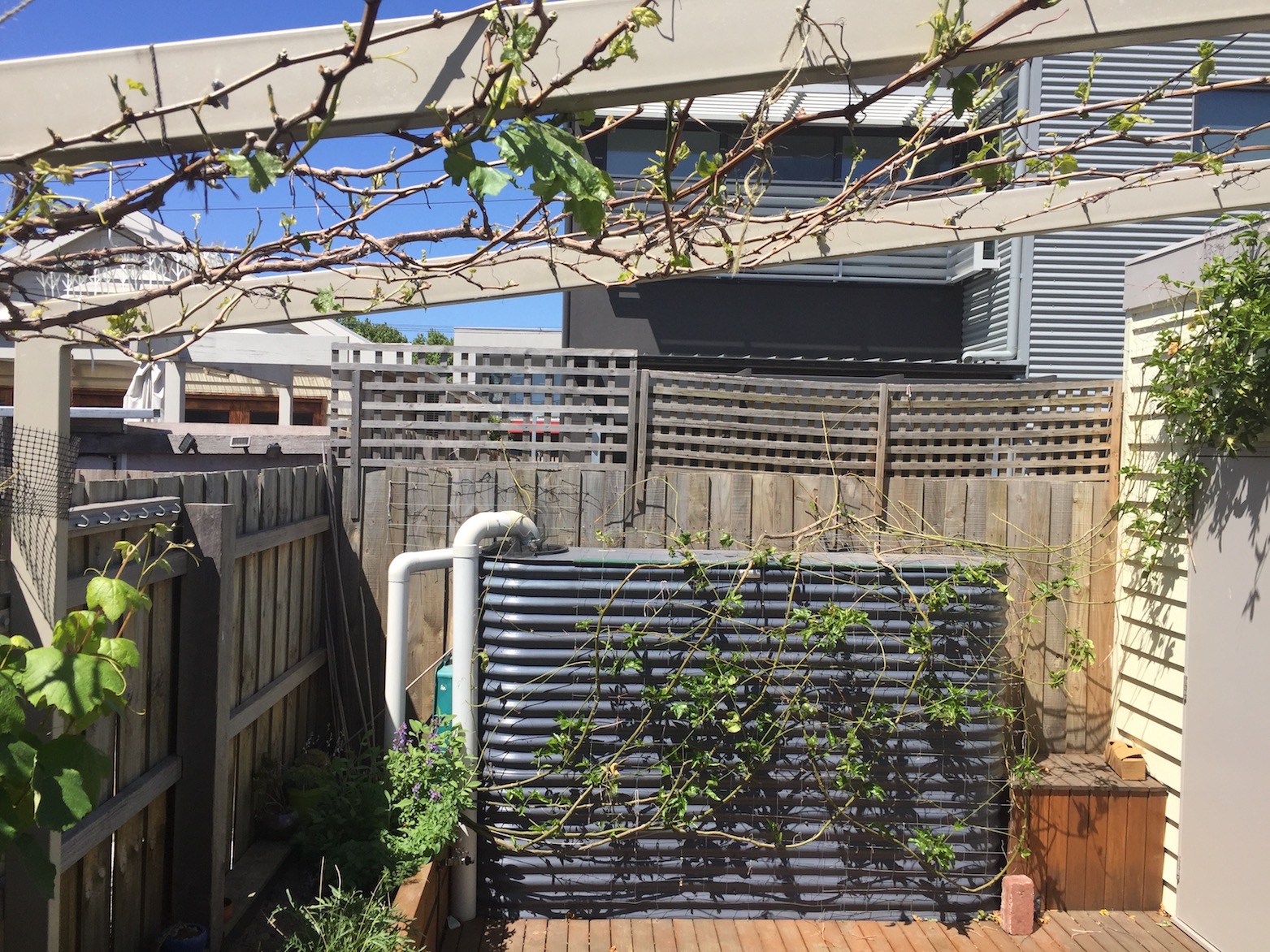
And the grapevine has been causing us great angst. It is happy in the raingarden, perhaps too happy, because it has become the favoured night-time snack of our local possum. The possum’s second and third favourite snacks have been the parsley and chard growing in the raingarden. It hasn’t touched any similar plants in any of the pots (or in the front raingarden): it just seems obsessed with the back raingarden, and particularly the grapevine over the pergola. Despite the array of spikes and other deterrents, it has repeatedly stripped almost all of the budding leaves from the grapevine, so that by now when it should be providing lots of shade, it is hardly providing any. I have taken to spraying a nightly dose of animal deterrent on all the buds, which has kept it off for a few nights. Here’s hoping for some shade before it gets too hot.
Part 8. Year 5: the grapevine fights back, pump pitfalls, a bigger thirstier grapevine
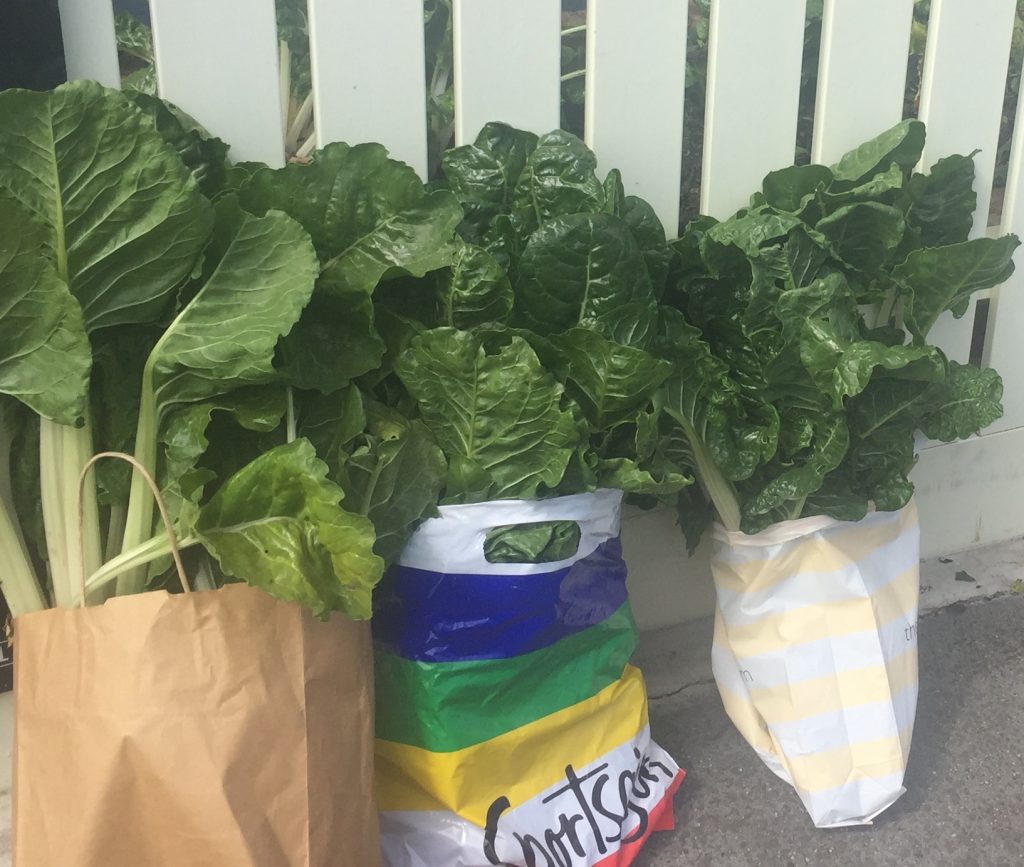
October 2018: The mysterious case of the disappearing possum. Remarkably, the monstrous brush-tail possum that mauraded our raingardens and nightly thumped across our roof last year has disappeared, despite carrying around an alarmingly large baby last autumn. Wandering the streets at night we only see the little (less-hungry, less heavy-footed) ring-tail possums that have been the dominant night-time fauna in our neighbourhood for all the years we have lived here. No idea what happened.
The electric-fence kit I bought on-line in a fit of desperation a few months ago seems unnecessary, as the grapevine shoots confidently across the pegola and the leafy greens of the raingardens go berserk. We have found ourselves with a healthy surplus of chard that we were driven to leave for passers-by to harvest.
November 2018: Pump pitfalls. My partner and I have a grand 5-month holiday planned from next March. We will be leaving the house and its stormwater management system in charge of the two girls, whose care factor for the system is low-to-moderate. It will be a good test for the resilience of the system when its resident users are less obsessive than I.
My major concern is the one aspect of the system that does require occasional manual intervention: the pump (a Vada V80-H for those who came in late). Five years on and it is still working without a hitch. However, the rain-to-main switch on top of the pump has never worked as I expected to (well, at all, really). Every time the tank has emptied, I have had to manually turn the pump off, and every time it has filled above the pump intake, I have had to manually turn the pump back on. Fortunately, this only happens once or twice a year, so it had never been a major annoyance, and I let it go.
But with us heading off for 5 months, and leaving it to the girls, I decided to have a closer look into why it wasn’t working.
When the tank empties to the level of the pump intake, the pump starts being noisy, taking in air as well water. A few times, we let it keep being noisy, taking an increasingly long time to fill the toilet cistern, until water flow was negligible. At no point, was there a hint of the ‘rain-to-main’ switching to the mains as expected.
On the advice of Rob, our resident sparky at work, I tested if it switched to mains if water supply from the tank was cut off completely (by turning off the inlet tap into the pump). And what do you know? It worked. The switch was working to its specification, but the gradual draw down of water from the tank, slowly reducing the inflow into the pump was too gradual to trip the switch.
Now, I might have put in the effort to think through a way to make it work better. But the exercise had spurred me to read the Rain-to-main’s specifications more carefully. Much to my surprise, it is designed only to do as it suggests: switch from rainwater to mains. It is not designed to switch back automatically, when the tank refills. I figured, that if I had to manually switch it back to rainwater, I might as well continue to put up with having to switch it to mains when it empties.
So, the upshot is that Vada’s Rain-to-main switch does not work on systems like ours with a gradual reduction of inflow to the pump, and it isn’t designed to do what I thought it was going to do (switch back and forth between tank water and mains water as the tank fills and empties). I’m going to continue to put up with it as it is until the pump dies (hopefully no time soon). When it does, I’ll investigate (with the help of smart colleagues) a switch that will do what we need.
18 January 2019: a bigger thirstier grapevine. The grapevine has done a sterling job of fighting back, but its canopy has only managed to extend to about three-quarters of the pergola. Not quite the full shade I have been hoping for, but next year is looking hopeful.
A consequence of the expanding grapevine canopy is that it has been using more water than ever before. I noticed yesterday that the sage was looking a bit sad in the back raingarden. And I found both raingardens to be very close to empty this morning. I filled the front from the downpipes (to 27 cm) as I have done in previous years. Until now, I hadn’t had to top up the back raingarden, and here, after five years, I most seriously regret not insisting that the tap in the back yard be connected to the tank’s pump.
The ‘gravity’ tap has been adequate for watering the pots in the backyard until now. But with the tank lower than the tap, I couldn’t use it to top up the raingarden. So, to fill the raingarden up from the tank, I needed to feed a hose through the house from the quail pen at the side of the house (several hundred litres to fill up the raingarden to a depth of 8.5 cm).
Part 9. Year 6: Fixing leaks; death of a passionfruit, bloom of a grape; the ABC visits; a bumper grape crop brings shade and wildlife
September 2019: Fixing leaks. We received very little rain in January and February, and the tank was empty when we we left on our holiday early March. the girls were happy enough to switch it back to rainwater when it rained a week later, and fortunately it didn’t empty again while we were away.
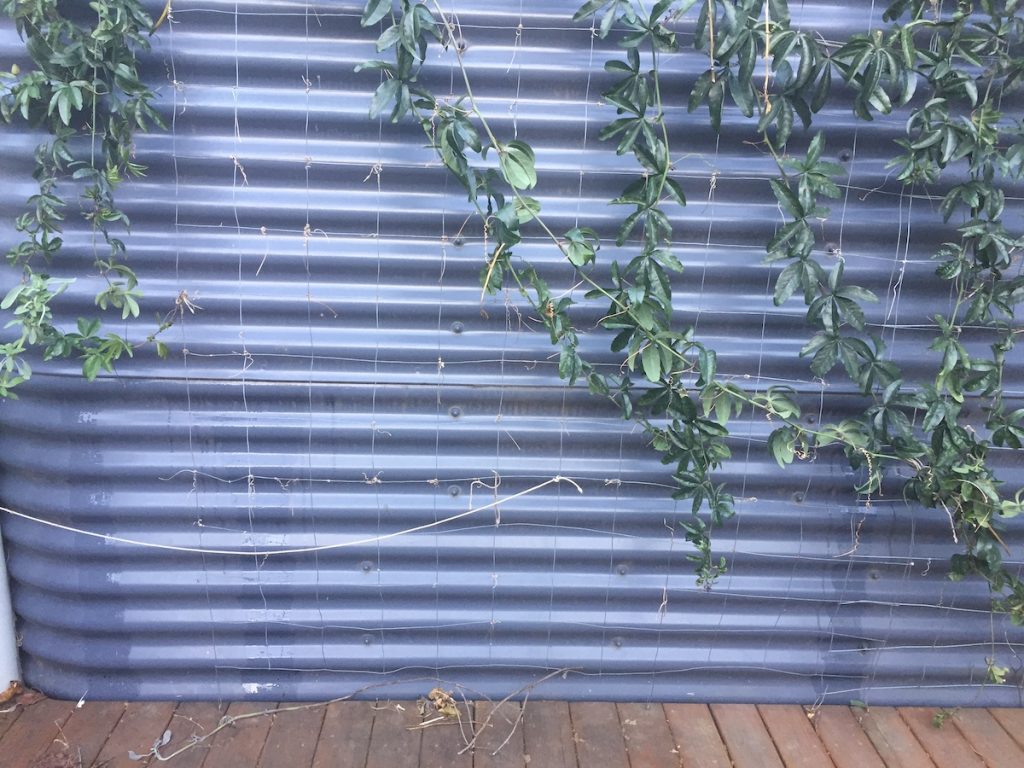
Pleasingly, it all worked well; they embraced using the veggies and only needed to turn the pump on once. However, soon after our return we noticed that the tank had begun to leak.
Disappointingly, there were multiple slow leaks along the horizontal seam half-way up the tank. After a lot of thought and advice and waiting for the tank to empty below the seam, I opted for using a sealant to seal along the seam from the outside. Once the tank had emptied and dried sufficiently, I used Selley’s SMP high-performance sealant, having been advised that I shouldn’t use a silicon-based sealant. I was expecting that the pressure from within would make this solution not work, but I was pleasantly surprised to find, next time it rained, that it worked. When the tank filled again, there was no sign of the leaks.
Now, I’m not 100% sure that there are no leaks on the other side of the tank (which is hard up against the fence), but, as far as I can see, there aren’t. Perhaps the sealant along the seam inside the tank perished along this side because it was subject to the hot afternoon sun. Nevertheless, it is disappointing to find a high-end tank like this springing leaks after 5 years.
If we had to replace the tank, it would be something of a logistical nightmare. (I have thought through our options and none of them easy. The most likely option would be using a lift over the back fence through the neighbour’s house. Almost certainly a replacement tank would require cutting into our decking, which was built around the tank. Luckily, it seems we have deferred this decision for some time.)
December 2019: death of a passionfruit, boom of a grape. As evident from the leaky tank photo above, the poor old grapevine was a shadow of its former self by September. As it withered, the grapevine of the neighbours behind was going wild over our back fence and doing a better job of covering the tank than our grapevine ever did.
So we embraced it as some extra greenery in our back yard, albeit not really part of the raingarden. It thus remained declared, but unstated, that when the ABC visited in November (see below) that I was speaking in front of some healthy greenery that wasn’t really my raingarden.
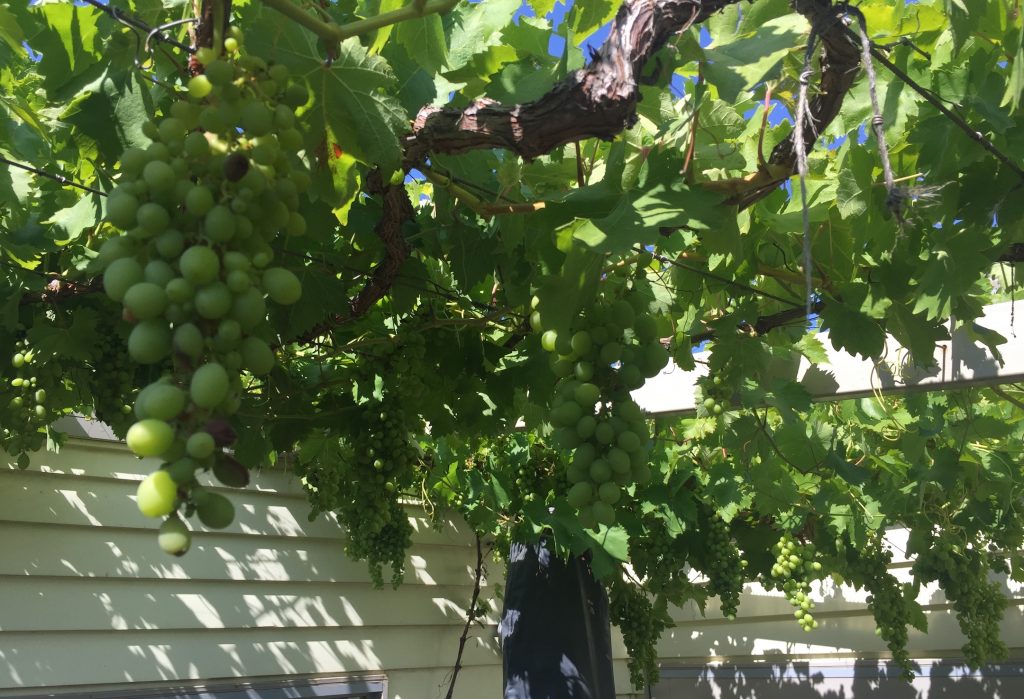
But the grapevine was growing spectacularly with a huge crop of grapes. Even the gingko that once looked like it wasn’t going to cope with wet feet has embraced life in the raingarden and has added 20 cm of height this last summer. At last we had the cooling summer shade that I had planned for, five years previously. With great shade and cooling came great water consumption, and after a particularly dry spring and early summer (9 weeks to 5 January with <20 mm of rain in total), we had come to an unprecedented situation after five years. An empty tank, and a near empty back raingarden.
I was able to keep the front garden going by emptying the downpipe into it, but with the tank empty, to keep the back garden going, I had to swallow my pride and top up the raingarden with a few hundred litres of mains water: I guess its not a bad effort for 5 and a half years of a productive garden.
January 2020: A visit from the ABC. Well, it was really November when Annah Fromberg from the ABC visited, but it wasn’t until January that producer Angela Ross put together a really great piece on how we need to change the way we manage stormwater, with our raingarden in a starring role. It was a pleasure to be involved.
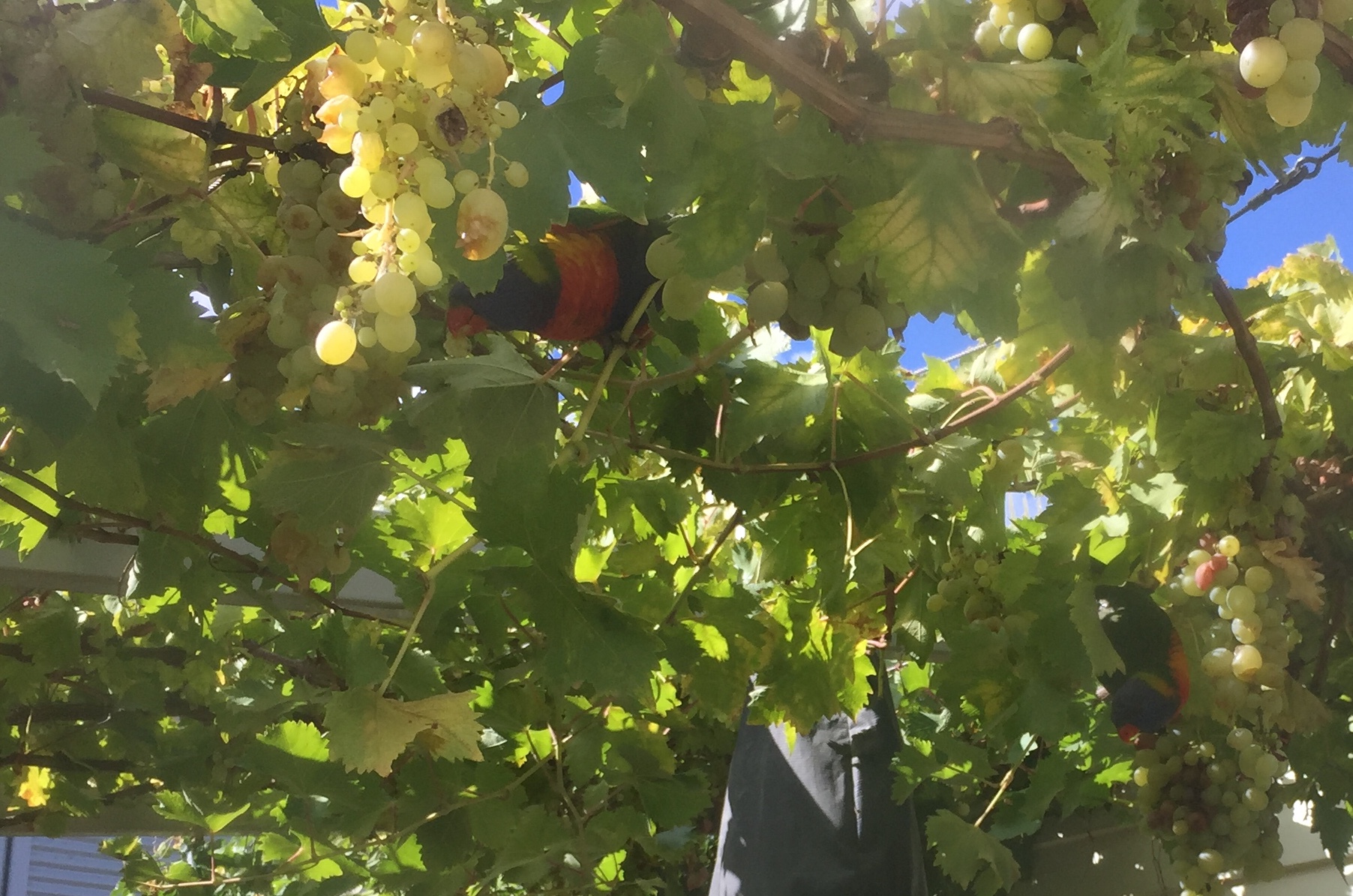
February 2020. a bumper grape crop brings shade and wildlife. And in the meantime, the grapes had begun to ripen. By February, we were harvesting more sweet grapes than we could eat each day (we gave a lot away). I didn’t weigh them all, but there would easily have been more than 25 kg of grapes on the vine. By March, we had given up trying to keep up with them, and the birds began to discover them. At first it was the Indian mynahs who we resented and assiduously shooed away. But then the wattle birds became more frequent, and more welcome visitors. And then we had regular morning visits from the rainbow lorikeets. They were messy eaters, and the decking was becoming a mess with the discarded half-eaten grapes, but we couldn’t bring ourselves to complain: we let them have the last of the crop.
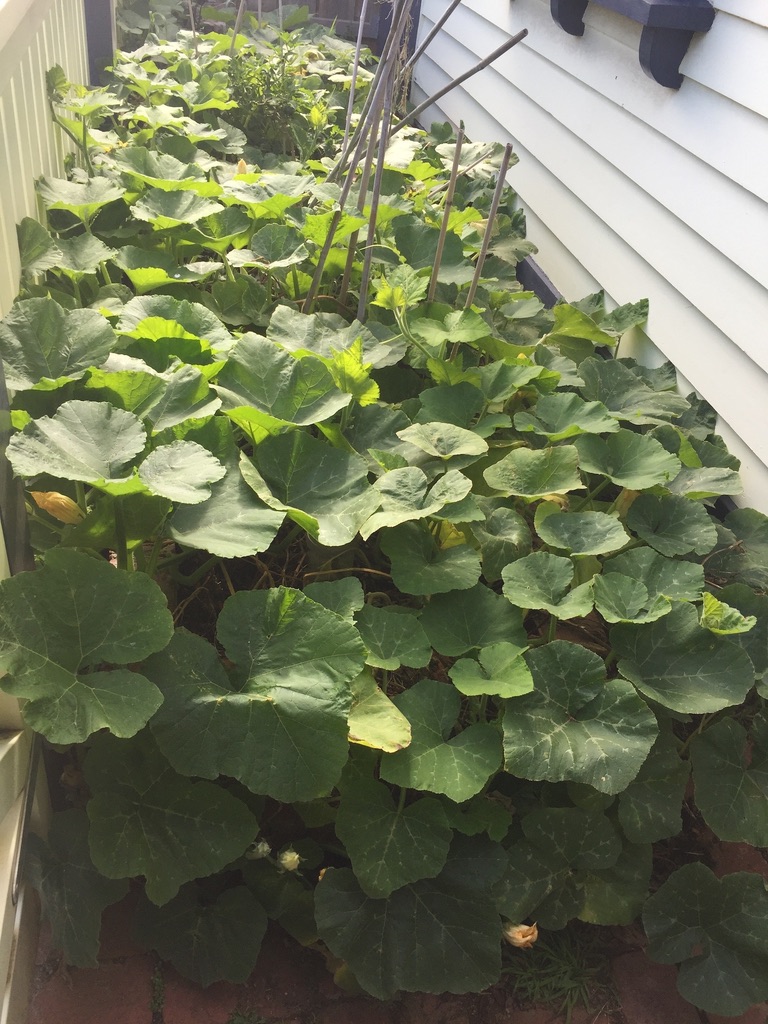
25 April 2020. Truth be told, I had neglected the raingarden diary for more than a year, and I have spent a fair slab of today (amidst the coronavirus lockdown) filling in missing news from an eventful year. It is difficult to believe that a year ago today we were cycling through an idyllic France en route from Madrid to Edinburgh…but that is for another diary. Back in locked-down Melbourne in 2020, the grapevine’s and the gingko’s leaves are yellowing and starting to fall. The multitude of parsley and rocket seeds in the back raingarden have become a lawn of seedlings ready for a winter crop, and the self-seeded pumpkins in the front garden have taken over. And as I finish for the night, rain is beginning to fall, with plenty of storage to retain the coming storm.
10 December 2021. The back raingarden has taken a festive turn, courtesy of recycled orange bags that I’ve put over the grape bunches in the vain hope that we might score more grapes than the birds this year. We do love the rainbow lorikeets visiting, but they are much less frequent visitors/pillagers than the Indian mynahs.
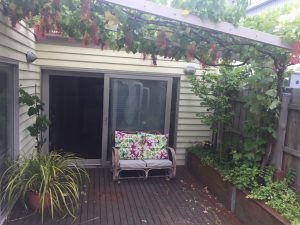 The grapevine has matured nicely and makes the courtyard a lovely shady place to sit on a warm summer’s day. The Gingko has certainly got over its early shock at having wet feet and has grown almost a metre in each of the last two summers: it is even starting to pay its way by contributing to the backyard shade.
The grapevine has matured nicely and makes the courtyard a lovely shady place to sit on a warm summer’s day. The Gingko has certainly got over its early shock at having wet feet and has grown almost a metre in each of the last two summers: it is even starting to pay its way by contributing to the backyard shade.
In the front raingarden this spring, we planted spinach, spring onions and chives, which have served us well. Now the spinach is going to seed, new tomato plants are taking over, self-seeded from last years crop. We have added some basil to the mix, as well as some strawberry plants transplanted from a garden in the mallee, where they were providing masses of strawberries. No such luck here yet: perhaps the raingarden is just not right for strawbs.
Over on the other side of the front garden, we have replaced the machelia, which we removed when most of its branches started looking diseased. We planted a small Eureka lemon tree in a raised bed, which seems to be happy enough. In June we planted a crop of garlic cloves under the lemon tree and have just harvested and plaited them to provide us with a garlic supply for at least a few months. It’s not really the raingarden, but it is irrigated with tank water, so contributing to keeping our stormwater on the property rather than down the drain.
The fact that this is the first raingarden diary post in a long time is a symptom of how little trouble the system has been: the tank and pump continue to go strong in their eighth year, and the tree and the grapevine in the back raingarden are making a big (summer) contribution to reducing the volume of runoff leaving the property.
30 January 2022. A new primary user of our property’s runoff
The raingarden has taken something of a turn this summer. With the grapevine providing shade to half of the back courtyard, and the Gingko having a 1-m growth spurt this year, the back raingarden has become the thirstiest user of our private water supply. The canopy area of the grapevine is now 12 square metres, making the total effective area of the back raingarden something like 15 square metres. With January 2022 evapotranspiration rates (according to the Bureau of meteorology) averaging 5.5 mm per day, the plants of the raingarden (with their unlimited water supply) could potentially be using ~80 litres each day (15 x 5.5).
And that seems to match the performance of our system over the last month. Despite a wet start to the year, the back raingarden got low on water twice during January, requiring a top-up from the tank. As a result, the tank emptied twice this month (once just for a day at the start of the month, and for three days before the rain began on 27 January). Over the month, the front raingarden didn’t empty at all (it came close at the start of the month, but had plenty of water before this week’s rain).
So, the back raingarden has really lifted its game. Now that there are only two of us living in the house most of the time, our uses inside the house have potentially dropped below 80 L/d, meaning the back raingarden is now king at helping retain stormwater on our property.
And to bang an old favourite drum, our almost empty system on 27 January had plenty of capacity to hold back the massive storms of 27 and 28 January. We’ve had 60 mm of rain in the last few days: including an amazingly intense storm on Friday that dumped ~30 mm of rain in a very short time. Once again, lots of reports of urban flash floods across Melbourne, but our property held back at least the first 20 mm of that storm.
The intense storm (and a similar one that hit earlier in the month) really tested our charged-downpipe system. The downpipe that receives runoff from the largest area of roof couldn’t cope and overflowed loudly for 5 minutes or so at the height of the storm. No great harm though. The water just collected in a puddle on the Lilydale toppings of our side lane, and soaked into the ground (no runoff to the street).
13 January 2023. Making the system auto-maintaining.
The grapevine has continued to thrive this year (although for the second year, the grapes have suffered from mildew- clearly I need to be treating them earlier in the system. But that aside, the vine has served its primary purpose of keeping the back yard shady and cool well. With that, comes more water usage, and once again, this year, I’ve found that the back raingarden in particular has come close to emptying twice, despite a relative wet start to summer, and I’ve had to add water from the tank to the raingarden.
This requirement for manual top-ups has been worrying me a little as we plan to head off on an extended holiday next year, leaving the house in the hands of others, and I don’t want to leave them with the burden of keeping the raingardens with sufficient water. So, I’ve invested in an automated irrigation system, and I’m quite impressed…




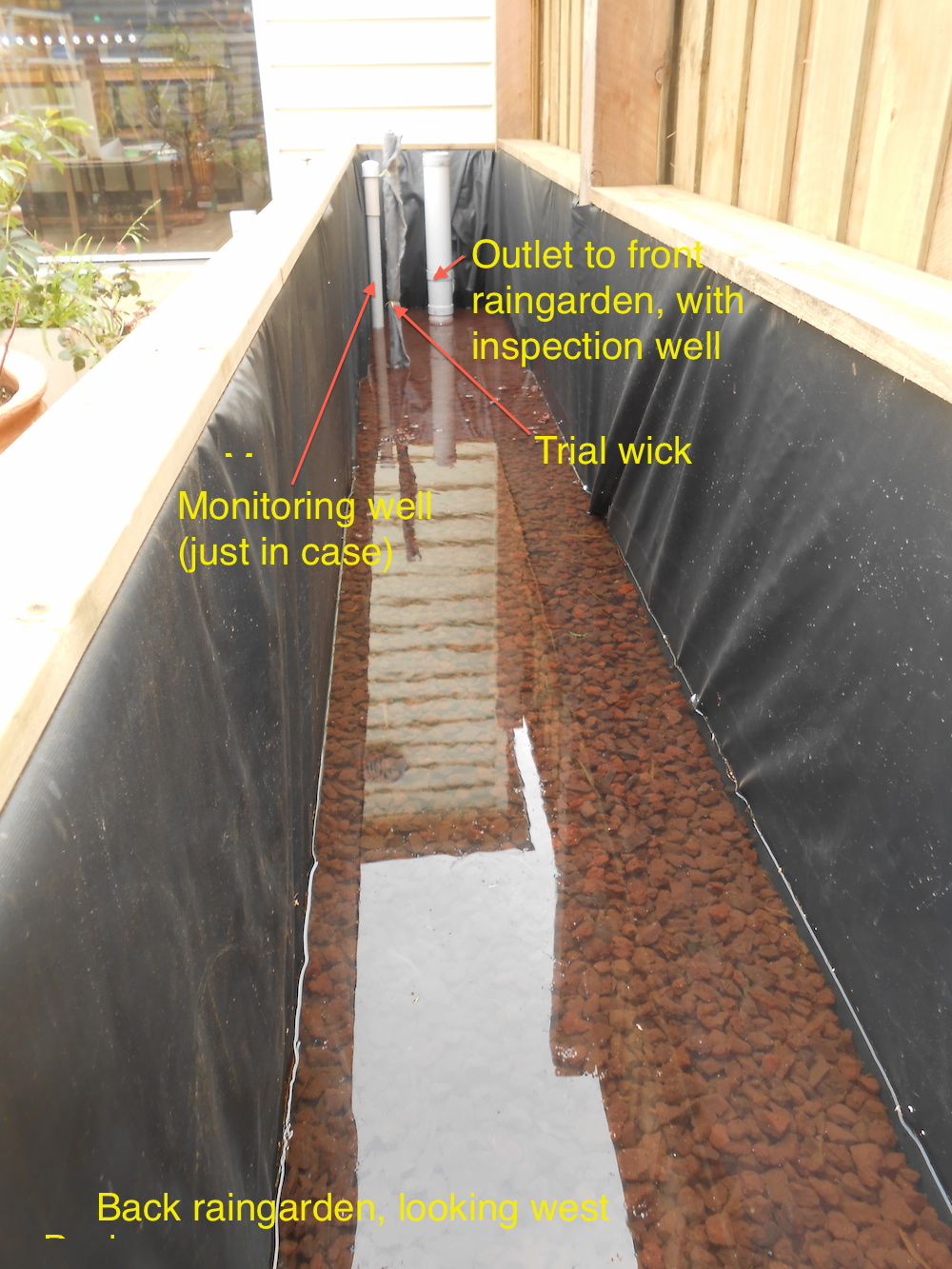
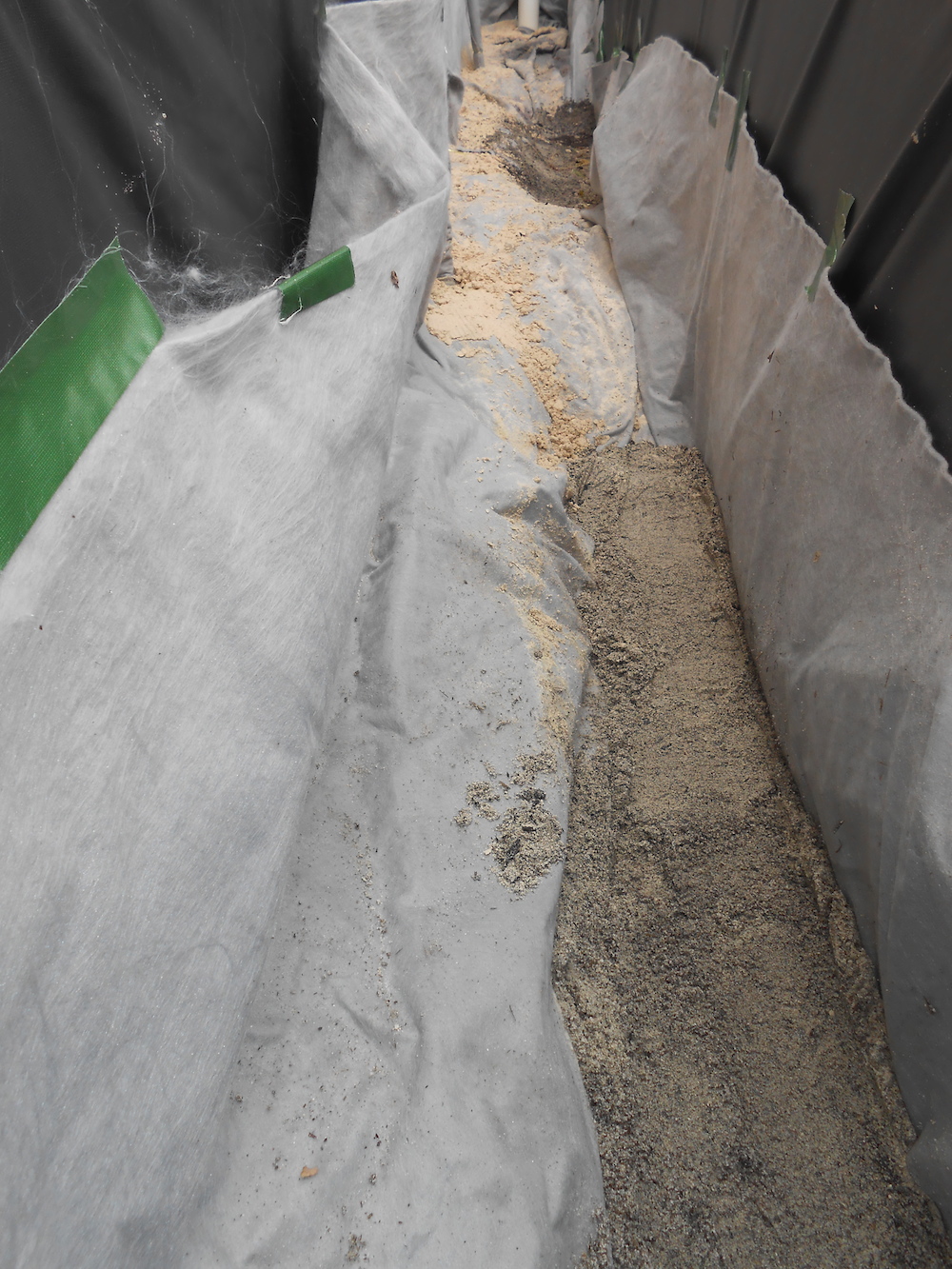
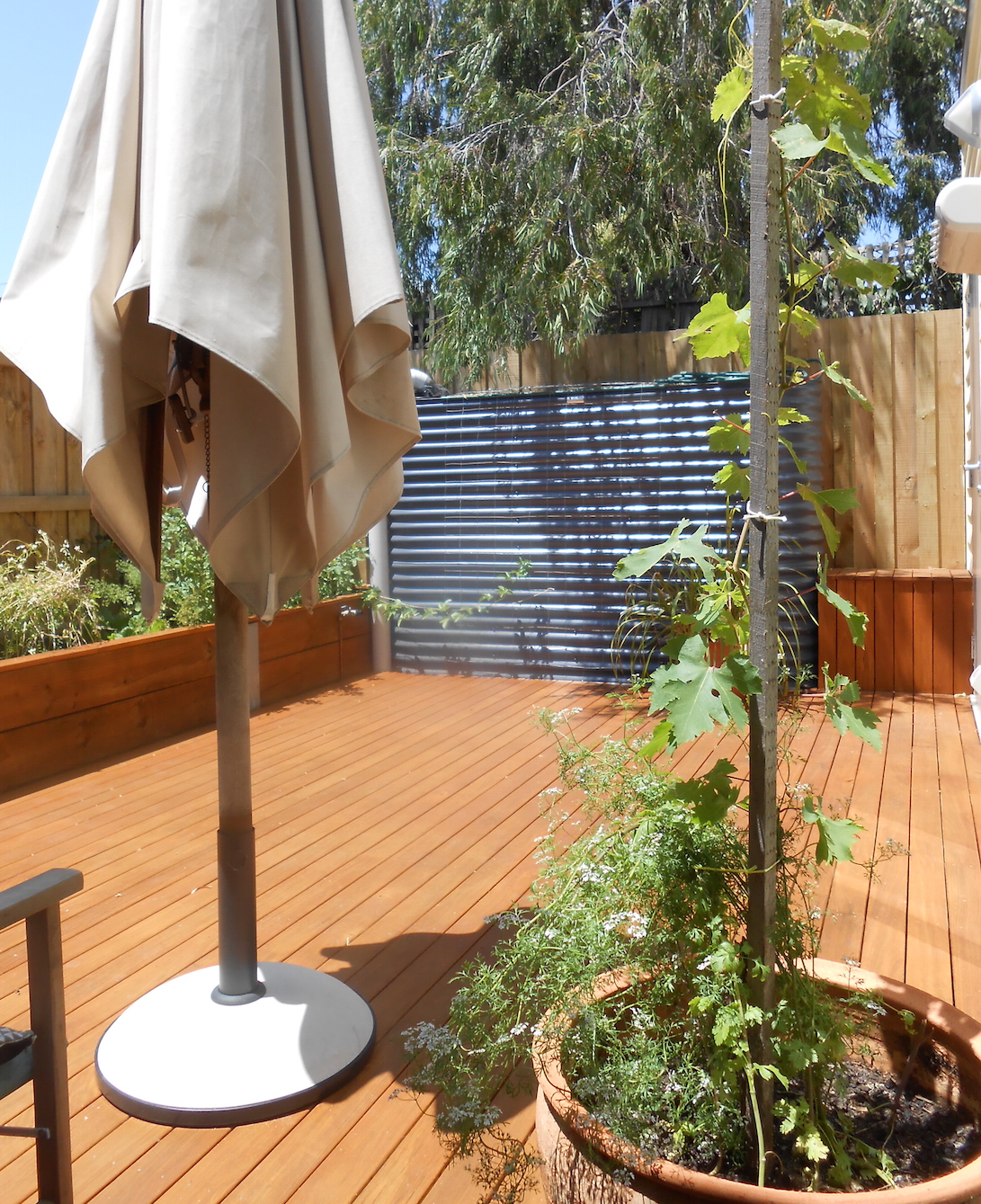
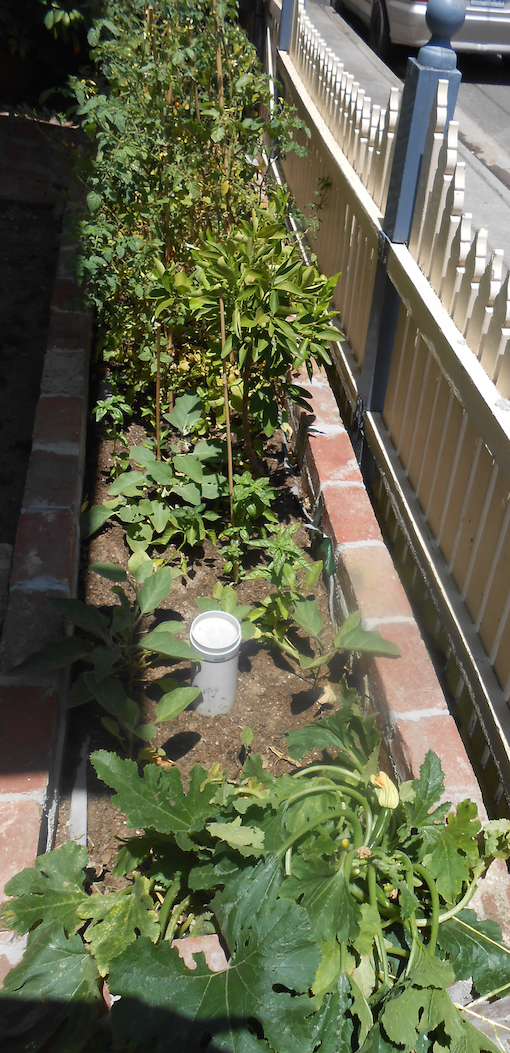

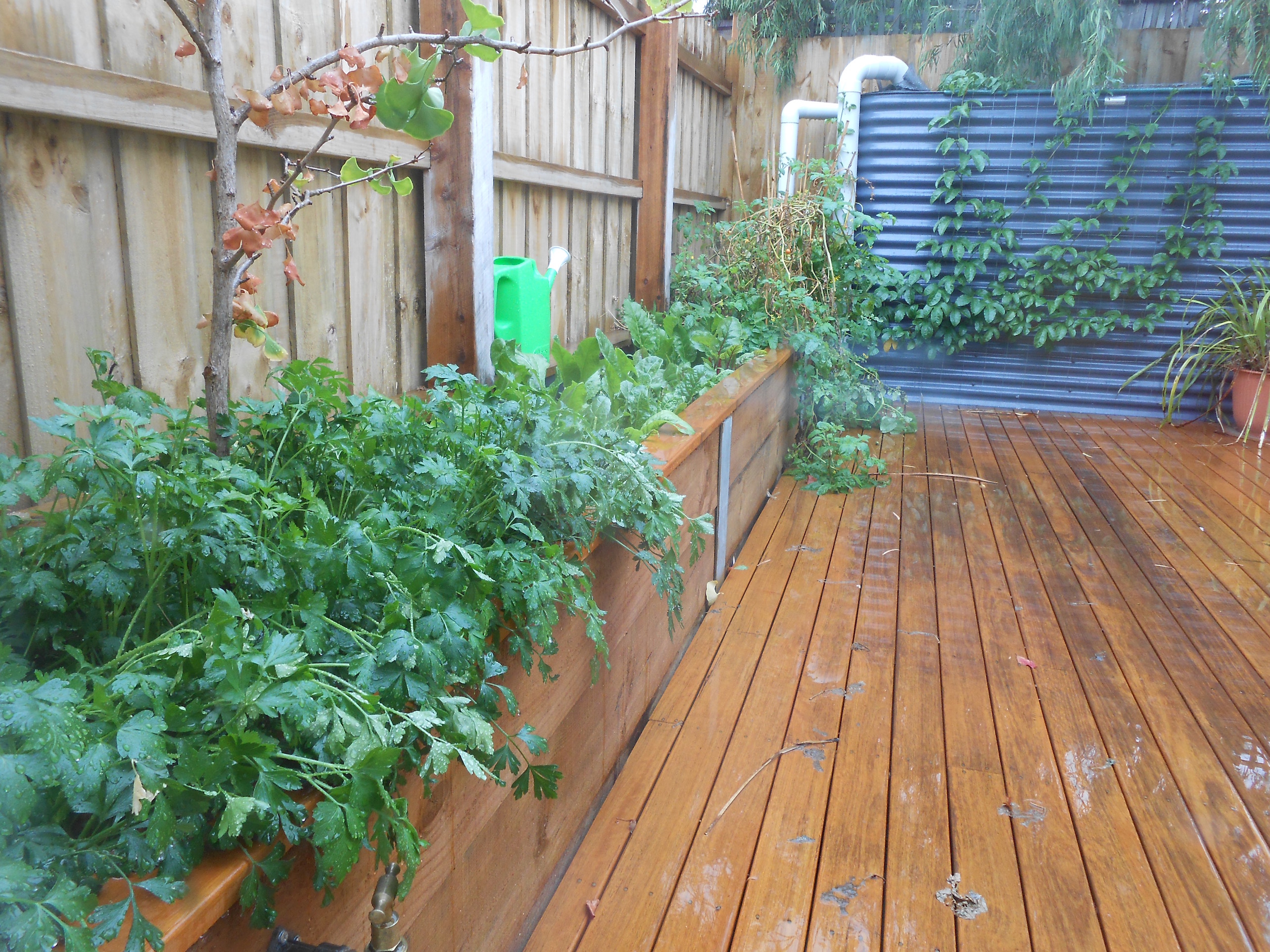
Hi Chris – this is a truly inspiring and valuable diary. We have completed a similar process over the last 15 years – we should compare notes and contrast results – can I place a link to your site on our website? Best wishes Peter
I started searching for “Arisa” and then “Arisa binning” then “Treeflap” and finally locating your spreadsheet macro which brought me close enough that I somehow wandered to here.
I was somewhat skeptical when I read your description of runoff as a “nasty cocktail of pollutants”. Since I see you are feeding your family on food grown using this cocktail – I assume your blanket description of runoff doesn’t apply to the water coming off your own house roof.
Fair enough concern Andy. Thanks for your skepticism.
There’s lots of evidence I could point you to that demonstrates the toxic and nutrient enrichment effects of urban stormwater runoff. The sources of the cocktail of pollutants found in stormwater are varied, and road runoff is usually of worse quality than roof runoff. Nevertheless, runoff from our zinc-alum roof almost certainly carries elevated levels of zinc, and likely other metals associated with the city soot that settles on our roof (which will certainly be carrying high levels of nitrogen, phosphorus and other contaminants).
So, why risk using it to produce food in our raingarden? Well, first our charged downpipe system and then our rainwater tank provide some initial treatment. Most of the fine soot and sediment washing from our roof settles in the bottom of our downpipe system (see here for evidence of this), and most of the remainder (not very much) settles in the bottom of the tank. (All of the [surprisingly large amount of] coarse particles washing off our roof that would also normally contribute to polluted stormwater runoff gets diverted to the ground by our downpipe filter guards). The raingarden soil provides a final treatment that makes the potential for contaminant accumulation no greater than a typical urban vegetable garden. Certainly tests of similar systems with less pre-treatment than ours suggest that we are not putting our health at risk by eating produce from our raingarden (See for instance Tom et al. 2013).
Tom, M., Richards, P., McCarthy, D.T., Fletcher, T., Farrell, C., Williams, N. & Milenkovic, K. (2013) Turning (storm)water into food; the benefits and risks of vegetable raingardens (Evaluation des performances et des risques d’un jardin de pluie potager). Novatech (eds J.-L. Bertrand-Krajewski & T.D. Fletcher). GRAIE, Lyon, France.
Thanks for posting Chris! Always a good read on a Sunday afternoon. As discussed in the Renew magazine, our house (similar to 3 million other houses in Australia) uses rainwater for all household purposes without any significant issues. But our rainwater harvesting system relies on a “natural” treatment train (your system does too) to improve rainwater quality (see the Residential Rainwater Guide on our website). Our Golden Retriever is a great companion and protector of our kitchen garden from possums – an interesting addition to the performance of the system at our place. Looking forward to comparing the stats from our houses in the near future
Hello Chris,
I’ve created wicking beds in the past but they have become stagnant if they don’t dry out. How have your beds gone over the 7 years?
Thanks
Hi Annabelle, I’m not sure what you mean by stagnant. Certainly the water in the stores at the bottom of our raingardens is anoxic (it’s smelly if I pump it up out through the inspection wells), but the plants don’t seem to mind. Is that what you mean? The underdrains in our beds ensure that the top 30-40 cm of soil remain well drained. Both gardens are very happy after 7 years. In fact the Gingko, which was quite unhappy for the first few years has really taken to its wet feet in the last couple of years and has grown a good meter or so, and the grapevine is happily growing heaps more shade again this year.